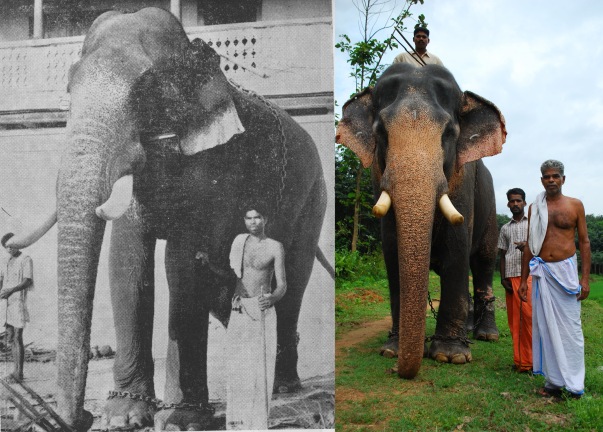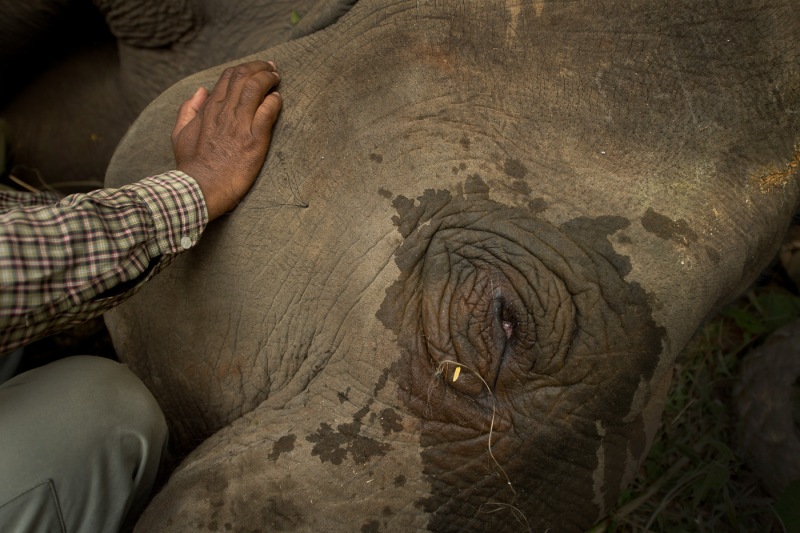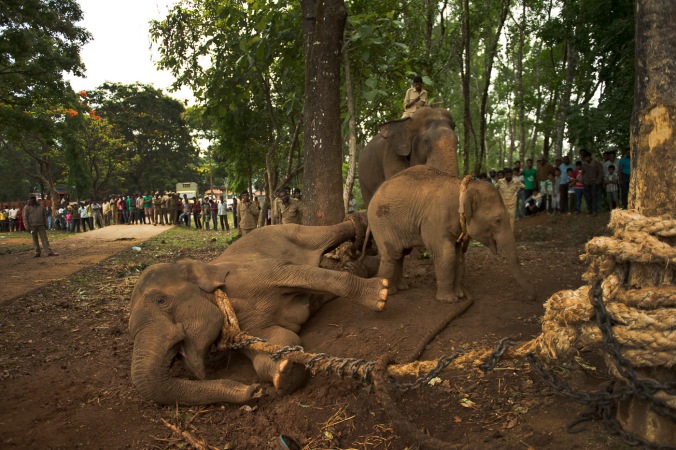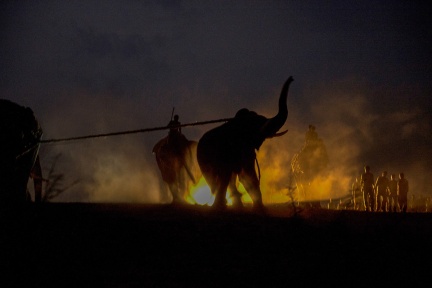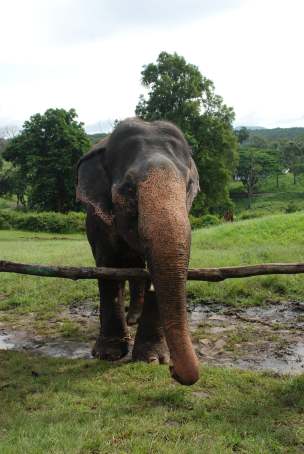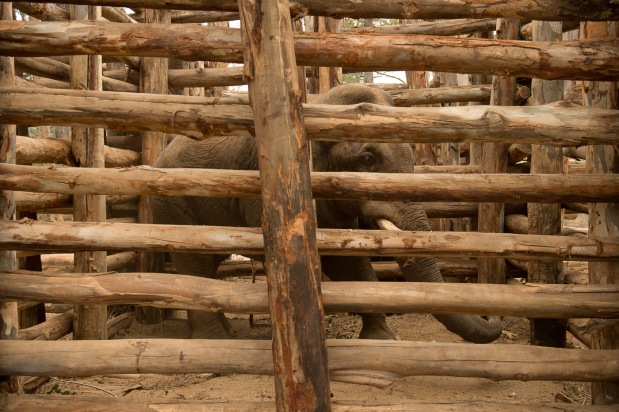ഇറ്റോർഫിന്റെയോ സൈലസീന്റെയോ പ്രവർത്തനം നിമിത്തം ഒരു ചെറു മയക്കത്തിലായിരുന്നു; മയക്കം പാതി വിട്ടുണർന്നത് പിൻകാലിലെ മുറിപ്പാടിൽ പ്രൊവിഡൻ അയഡിൻ സൊല്യൂഷനിൽ മുക്കിയ പഞ്ഞി ആഴ്ന്നിറങ്ങിയപ്പോഴാണ്. വേപ്പെണ്ണയുടെ മണം കലർന്ന സ്പ്രേ അടിച്ചപ്പോൾ കണ്ണിൽ നിന്ന് പൊന്നീച്ച പറന്നു; പണ്ട് കൂട്ടത്തിലെ മറ്റൊരു പ്രമുഖൻ കേറി കുത്തി വാൽ കടിച്ചെടുത്തപ്പോഴുണ്ടായ നീറ്റൽ ഓർമപ്പെടുത്തിയ പോലെ തോന്നി അവന്. മുറിപ്പാടിന് ദിവസങ്ങളുടെ പഴക്കമേയുള്ളൂ; പണ്ടായിരുന്നെങ്കിൽ മുളങ്കൂട്ടങ്ങളുടെ നടുക്കുള്ള വയലിലെ ചെളിയോ പുഴയുടെയോ ഡാമിന്റെയോ കരകളിൽ കാണുന്ന മണ്ണോ സഹായകരമായേനെ. ഇടയ്ക്കെപ്പോഴോ കണ്ണോടിച്ചപ്പോൾ തന്റെ ചുറ്റിനും നിരത്തി വെച്ചിരിക്കുന്ന പ്രാഥമിക ശുശ്രൂഷക്കാവശ്യമായ വസ്തുക്കൾ കണ്ടപ്പോഴായിരിക്കണം അവന് സ്ഥിതിഗതികളുടെ ഗൗരവം മനസ്സിലായിട്ടുണ്ടാവുക. നടയമരങ്ങൾ നീട്ടി ചുറ്റിനും നിന്നിരുന്നവരെ ആട്ടിയോടിച്ചിരുന്നത് അതോട് കൂടി നിർത്തി; സഹകരിക്കാൻ തീരുമാനിച്ചു. മുറിവ് വൃത്തിയായി കഴുകി മരുന്ന് വെച്ച് മയക്കം വിട്ടുണരാനുള്ള മറുമരുന്ന് കൊടുത്ത് ചികിത്സകരും പരിചാരകരും മടങ്ങി അല്പനിമിഷത്തിനുള്ളിൽ അവൻ ആ തിരിച്ചറിവിലേക്ക് വന്നു, താൻ കിടക്കുന്നത് ഒരു വലിയ കൂട്ടിനകത്താണ്. പണ്ട് കുത്തിക്കീറി ഉള്ളിലെ മധുരം ആസ്വദിച്ചിരുന്നു തൈലമരം എന്നറിയപ്പെടുന്ന യൂക്കാലിപ്റ്റസ് മരങ്ങളുടെ. അവയുടെ കഴകളുടെ സുഗന്ധം അവനിൽ വനവ്യഥകളുണർത്തി. മയക്കം പൂർണമായി വിട്ട നേരം എതിർത്തിട്ട് കാര്യമില്ലെന്ന തിരിച്ചറിവ് വന്നിരുന്നു. തന്റെ കൂട്ടത്തിലെ മറ്റൊരുവൻ സ്വാതന്ത്ര്യത്തിന്റെ മധുരം നുകരാൻ കഴകൾ പൊളിക്കാനുള്ള ശ്രമത്തിനിടെ തന്റെ ഗംഭീര മസ്തകത്തിലേറ്റ ആഘാതത്തെ തുടർന്ന് ഇഹലോകവാസം വെടിഞ്ഞ കഥ അവൻ കേട്ടിരുന്നു.
കൂരിക്കൊമ്പന്റെ വാശിയൊക്കെ അടങ്ങിയ മട്ടാ––ഉറക്കെ ഉയർന്ന് കേട്ടത് മലയവിഭാഗത്തിൽപ്പെട്ട ഒരുവന്റെ ശബ്ദമായിരുന്നു. തന്റെ മേലുദ്യോഗസ്ഥനോട് കാട്ടുകൊമ്പന്റെ സ്വഭാവത്തിൽ വന്ന പ്രകടമായ മാറ്റം എടുത്ത് പറഞ്ഞപ്പോൾ അവനിൽ ഉത്സാഹം.
……ഉദ്വിഗ്നാശ്ച മന:ശരീരജനിതൈര്
ദുഃഖൈരതീവാക്ഷമാ:
പ്രാണാന് ധാരയിതും ചിരം നരവശം
പ്രാപ്ത: സ്വയൂഥാദഥ…
നൂറ്റാണ്ടുകൾക്ക് മുന്നേ ഗജശാസ്ത്രം രചിച്ച പാലകാപ്യ മഹർഷിയുടെ വരികളാണ്–– ആനകൾ തങ്ങളുടെ പ്രാണൻ നിലനിർത്താൻ ചിരകാലം മനുഷ്യരുടെ അധീനതയിൽ വസിക്കേണ്ടതായി വരുന്നു എന്ന് സാരം. കൂരിക്കൊമ്പനെ പോലുള്ളവരുടെ ഈ തിരിച്ചറിവ് തന്റെ വിജയമായി കാണുന്നു മനുഷ്യൻ പലപ്പോഴും. തന്റെ ആധിപത്യം സ്ഥാപിച്ചു എന്ന് കരുതുന്ന മനുഷ്യൻ പക്ഷെ തുടർന്ന് പാലകാപ്യൻ പരാമർശിച്ചത് എന്ത് കൊണ്ടോ ഒരിക്കലും ശ്രദ്ധിച്ചില്ല, അല്ലെങ്കിൽ മുഖവിലയ്ക്കെടുത്തില്ല. രാജ്യഭ്രഷ്ടനായ രാജാവിന് സമനായി പാലകാപ്യൻ വർണ്ണിക്കുന്ന കാട് കൈവിട്ട കരി സ്വതന്ത്ര ജീവിതത്തിൽ അനുഭവിച്ച സുഖങ്ങളെ കുറിച്ചും ചെയ്തു പോന്നിരുന്ന ക്രീഡകളെ കുറിച്ചും ചിന്തിച്ച് വിഷണ്ണനായി മരണത്തെ വരിക്കാൻ സാധ്യത ഉള്ളതിനാൽ അവയുടെ ധാതുപുഷ്ടിക്ക് ജലക്രീഡയും പാംസുസ്നാനവും ദേഹരക്ഷയും ചെയ്യേണ്ടിയിരിക്കുന്നു. ഇതെല്ലാം വനവിരഹിതനായ കളഭചരിതം. ഈയൊരവസ്ഥ ഇവർക്കെങ്ങനെ കൈവന്നു, അല്ലെങ്കിൽ ഗജക്ലേശവും മൃത്യൂപയാനവും എവിടെ തുടങ്ങുന്നു എന്നതിൽ പ്രാമുഖ്യം കൊടുക്കാം––വിളക്കുമാടത്തിൽ നിന്നുള്ള വെളിച്ചം ആ ദിശയിലേക്ക് തിരിച്ച് നോക്കാം.
പാലകാപ്യൻ കുറിച്ചതിങ്ങനെ––കൃഷി സ്ഥലങ്ങളിലെ ക്രീഡ മൂലം ജനങ്ങൾക്ക് ക്ലേശം സൃഷ്ടിച്ചിരുന്ന ആനകളെ രോമപാദ മഹാരാജന്റെ സേന ബന്ധനസ്ഥരാക്കി കൊട്ടാരക്കൊട്ടിലിൽ കൊണ്ട് വന്ന് തളച്ചു. രാജകല്പനയ്ക്കപ്പുറം ഒന്നുമില്ലെന്നൊരു കാലഘട്ടത്തിൽ ഇത്തരമൊരു നടപടിയുടെ ഉറവിടവും പ്രചോദനവും ഊഹിക്കാം. തുടർന്ന് വന്യതയുടെ ഈ സ്വരൂപങ്ങളെ എങ്ങനെ രാജ്യപുരോഗതിക്കും മനുഷ്യോപയോഗങ്ങൾക്കും നിയോഗിക്കാമെന്ന വിശദമായ കുറിപ്പുകൾ പദ്യരൂപേണ രചിച്ച് ഗജശാസ്ത്രത്തിന്റെ വേരുകൾ ആഴത്തിൽ നാട്ടി, പാലകാപ്യ മഹർഷി. എന്നാൽ അർത്ഥശാസ്ത്രത്തിൽ കൗടില്യൻ ഊന്നൽ നൽകിയ പോലെ ഗജവനങ്ങൾ, വന്യഗജസംരക്ഷണത്തിനായി, സ്ഥാപിക്കുന്നതിന് നൽകേണ്ട പ്രാധാന്യത്തെ കുറിച്ച് പിന്നീടൊരു ശാസ്ത്രത്തിലും പ്രതിപാദിച്ച് കണ്ടില്ല. ഈസ്റ്റ് ഇന്ത്യ കംബനിയുടെ നേതൃത്വത്തിൽ രാജ്യത്തുടനീളം വനങ്ങൾ ഉപഭോഗവസ്തുക്കളുടെ ഉൽപാദനത്തിനായി വെട്ടി തെളിച്ചപ്പോൾ അപൂർവയിനം ജീവജാലങ്ങൾ വംശനാശം കൈവരിച്ച് പട്ടികയിൽ നിന്നും മാഞ്ഞ് പോയത് പലരുടെയും ശ്രദ്ധയിൽ പെട്ടില്ലായിരിക്കാം. ഇമ്പീരിയൽ ഫോറെസ്റ് ഡിപ്പാർട്മെന്റിന്റെ ലക്ഷ്യം രാജ്യത്തെ റെയിൽവെ ഉൾപ്പെടെയുള്ള വ്യാവസായിക സംരംഭങ്ങൾക്ക് വേണ്ട തടിയുൽപാദനം മാത്രമായിരുന്നു. 1800കളുടെ അവസാനപാദത്തിൽ സർക്കാർ ആവശ്യങ്ങൾക്കായി ഖെദ്ദ മുറയിൽ അനവധി ആനകളെ മൈസൂർ കാടുകളിൽ നിന്നും പിടിക്കുകയും വിനോദാവശ്യങ്ങള്ക്കായി വെടി വെക്കുകയും (ട്രോഫി ഹണ്ടിങ്) ചെയ്തപ്പോൾ പക്ഷെ അന്നത്തെ മദ്രാസ് പ്രെസിഡെൻസി ഇതിൽ നിന്നും വ്യത്യസ്തമായി 1873ൽ മദ്രാസ് എലിഫന്റ് പ്രിസർവേഷൻ ആക്ട് നടപ്പിലാക്കുകയും നിയമലംഘനം നടത്തുന്നവരെ ക്രൂശിക്കുന്നതിന് നടപടികൾ സ്വീകരിക്കുകയും ചെയ്തുവത്രേ. നൂറ്റാണ്ടിനിപ്പുറം ശ്രീമതി ഇന്ദിരാ ഗാന്ധിയുടെ അശ്രാന്തപരിശ്രമങ്ങളുടെ ഫലമായി 1972ൽ രാജ്യത്തെ ഏറ്റവും വലിയ വന്യമൃഗസംരക്ഷണ മാർഗരേഖയായി വന്യജീവി സംരക്ഷണ നിയമം (1972) നിലവിൽ വന്നപ്പോൾ ഒന്നാം പട്ടികയിലുൾപ്പെട്ട ആനയുൾപ്പെടെയുള്ള ജീവികളുടെ സംരക്ഷണത്തിന് പ്രതീക്ഷ കൈവന്നുവെങ്കിലും തുടർന്നും അനധികൃത വനനശീകരണം സ്വാഭാവിക ആവാസവ്യവസ്ഥൾക്ക് ഭേദമാക്കാൻ കഴിയാത്തവണ്ണം ക്ഷതമേല്പിച്ചു.
ഒരു പ്രധാന വനമേഖലയിൽ നിന്നും മറ്റൊന്നിലേക്ക് ആനകൾക്ക് നീങ്ങാനുള്ള ഇടനാഴികൾ, അഥവാ പാതകളാണ് ആനത്താരകൾ എന്നറിയപ്പെടുന്നത്. വനമേഖലയ്ക്കകത്തും ചുറ്റിനുമായി ഏറി വന്ന സമ്മർദ്ദങ്ങൾ ഇത്തരം ഇടനാഴികളെ കാർന്ന് തിന്നപ്പോൾ അവിടം മനുഷ്യവാസകേന്ദ്രങ്ങളായി. ആനകളും മറ്റ് വന്യമൃഗങ്ങളും പക്ഷെ തങ്ങളുടെ ആ ആവാസമേഖലയെ വിട്ട് പോവാൻ തയ്യാറായില്ല. മാറ്റങ്ങൾക്കനുസൃതമായി സ്വഭാവവ്യതിയാനങ്ങൾ കൈവരുത്തിയ ജീവജാലങ്ങൾ ഇത്തരം വൻകിട മാറ്റങ്ങളെ അതിജീവിച്ചു. അത്തരം ജീവജാലങ്ങളിൽ പ്രഥമസ്ഥാനീയർ തന്നെ ആനകൾ. തൊണ്ണൂറുകളോടെ മനുഷ്യ-വന്യജീവി സംഘർഷം സമകാലീനപ്രശ്നങ്ങളിൽ ഏറ്റവും വലുതായി വളർന്ന/ചിത്രീകരിക്കപ്പെട്ട സാഹചര്യത്തിൽ ആനകൾ വീണ്ടും പഴയ രോമപാദയുഗത്തിലേക്ക് തള്ളപ്പെട്ടു. പ്രശ്നബാധിതമേഖലകളിൽ നിന്നും ആനകളെ പിടികൂടുകയോ നാടുകടത്തുകയോ ആണ് മാർഗമെന്ന് വരുത്തിത്തീർക്കപ്പെട്ടു. മറ്റേതെങ്കിലും സാധ്യമായ മാർഗങ്ങൾ പരീക്ഷിക്കാനോ സ്വീകരിക്കാനോ ബന്ധപ്പെട്ട അധികൃതരെ അനുവദിക്കാത്തവണ്ണം രാഷ്ട്രീയ-സാമൂഹ്യ സമ്മർദ്ദങ്ങൾ വർധിച്ച് കൊണ്ടേയിരുന്നു. മുൻപേ പരാമർശിച്ച സ്വഭാവവ്യതിയാനങ്ങളും ആവാസവ്യവസ്ഥാനാശവും കൃഷിസ്ഥലങ്ങളിലെ പോഷകക്കൂടുതലുള്ള വിളകളും കാട്ടാനകളെ നിരന്തരം മനുഷ്യവാസകേന്ദ്രങ്ങൾക്കരികെ എത്തിച്ച് കൊണ്ടിരുന്നു. എന്നാൽ പ്രശ്നം ആനകൾക്കല്ലെന്നും അതാത് സ്ഥലങ്ങൾക്കാണെന്നും വർഷങ്ങൾക്കിപ്പുറവും തിരിച്ചറിവ് ഉണ്ടായിട്ടില്ല എന്നത് തികച്ചും ഖേദകരം തന്നെ, ഒട്ടനവധി ശാസ്ത്രസാങ്കേതിക പുരോഗതികൾക്ക് ശേഷവും !
കർണാടകയിലെ ഹാസൻ-കുടക് മേഖല ഇതിന്റെ ഉദാത്തമായ ഉദാഹരണമാണ്. രണ്ട് പതിറ്റാണ്ടിനുള്ളിൽ അൻപതോളം ആനകളെ പിടികൂടി കൂട്ടിലടയ്ക്കുകയും നാടു കടത്തുകയും ചെയ്തിട്ടും ഇന്നും അവിടെ കാട്ടാനകൾ മൂലമുള്ള കൃഷി, മനുഷ്യ ജീവനഷ്ടങ്ങൾക്ക് അറുതി വന്നിട്ടില്ല. ആനകളില്ലാതിരുന്ന മേഖലയായിരുന്ന ഹാസനിൽ എവിടെ നിന്നും ആനകൾ വന്നു എന്ന് ചോദിക്കുന്ന തോട്ടമുടമകളും കർഷകരും പക്ഷെ 1970കളിൽ വരെ ആ മേഖലയിൽ നിന്ന് സർക്കാർ കാട്ടാനകളെ പിന്തുടരുകയും ആനപ്പിടുത്തം നടത്തുകയും ചെയ്തിരുന്നത് അറിയാത്തതോ അവഗണിക്കുന്നതോ? തോട്ടം മേഖല വികസിച്ചപ്പോൾ നഷ്ടപ്പെട്ട് പോയ കട്ടേപുര കാടുകളും, ദൊഡ്ഡബെട്ട വനംപ്രദേശവും ഒരു കാലത്ത്, ഒരുപാട് മുൻപല്ല താനും, ആനകൾ സ്വൈര്യവിഹാരം നടത്തിയിരുന്ന മേഖലയായിരുന്നു.
സഞ്ചാരസ്വാതന്ത്ര്യ നിഷേധത്തിന് നിയമപ്പോരാട്ടങ്ങൾ നടക്കുന്ന ഇന്നത്തെ കാലഘട്ടത്തിൽ അട്ടപ്പാടിയിലെയും ആനക്കട്ടിയിലെയും വാളയാറിലെയും ആനകൾക്ക് ഒരു വിധത്തിൽ പറഞ്ഞാൽ നീതി നിഷേധിക്കപ്പെടുകയാണ്; ഒരു വലിയ “E”യുടെ മാതൃകയിലേക്ക് ചുരുങ്ങിക്കൂടികൊണ്ടിരിക്കുന്ന കോയമ്പത്തൂർ വനമേഖലയിലെ ഈ തലമുറയിലെ ആനകൾക്ക് കാടുകളേക്കാൾ ഒരുപക്ഷെ ചോളനിലങ്ങളും കരിമ്പിൻ തോട്ടങ്ങളും ചെങ്കൽചൂളകളുമാവാം കൂടുതൽ പരിചയം. വാലിൽതൂങ്ങിയും ആർത്ത് വിളിച്ചും കൂകിയും കുടിയേറ്റ തൊഴിലാളികൾ നിത്യേന ആനകളെ കാട് കയറ്റുമ്പോൾ ആരും മനസ്സിലാക്കുന്നില്ല, ഇത്തരം പ്രവൃത്തികളുടെ ഭവിഷ്യത്തുകൾ.ആനകൾക്ക് ഭയം തീർത്തും നഷ്ടപ്പെട്ട് കഴിയുമ്പോ ആക്രമണങ്ങൾ ഒഴിച്ച് കൂടാനാവാത്ത ഒരു പ്രശ്നമായി മാറിയേക്കാം. ഇതിന്റെ തെളിവുകൾ മേൽപ്പറഞ്ഞ മേഖലയിൽ തന്നെ വർധിച്ച് വരുന്ന മനുഷ്യ ജീവഹാനിയുടെ രൂപത്തിൽ ഉടലെടുത്തത് കഴിഞ്ഞു. പകൽ മുഴുവനും ഒരർത്ഥത്തിൽ സ്വാതന്ത്ര്യം നഷ്ടപ്പെട്ട് ഇടക്കാടുകളിൽ മറ പിടിച്ച് നിന്ന് രാത്രിയുടെ മറവിൽ തങ്ങളുടെ പെരുവയർ നിറയ്ക്കാൻ ഇറങ്ങുമ്പോഴാണ് വീണ്ടും മനുഷ്യരുടെ മുന്നിൽപ്പെടുന്നതും അപകടങ്ങൾ സംഭവിക്കുന്നതും. താരതമ്യേന ധൈര്യക്കൂടുതൽ (bolder) ഉള്ള ചില ആനകൾ പകൽ പുറത്തിറങ്ങുന്നതോടെ അവ ആക്രമണകാരികളായി. പിന്നെ സ്ഥിരം നടപടികൾ––തെളിയാത്ത എല്ലാ “ആനക്കൊലകളും” അവന്റെ/അവളുടെ തലയിൽ വെച്ച് കെട്ടി കൊലയാന പട്ടം ചാർത്തി ആഘോഷിക്കുകയായി. മാധ്യമങ്ങളിൽ ചർച്ചകൾ കൊടുമ്പിരിക്കൊണ്ട് തുടങ്ങിയാൽ മേൽനടപടിയെന്നോണം അറസ്റ്റും ജയിൽവാസവുമായി.
ഇത്തരം സന്ദർഭങ്ങളിലെ അറസ്റ്റ് അഥവാ ആനപ്പിടുത്തത്തിന് എത്തുന്ന ആനപൊലീസാണ് താപ്പാനകൾ അഥവാ കുങ്കിയാനകൾ. കഥയിലെ കൂരിക്കൊമ്പൻ ഉൾപ്പെടെ ഒട്ടനവധി ആനകൾക്ക് കടിഞ്ഞാണിടാൻ ഉതകുന്ന ഈ ആനപ്പട്ടാളം കഠിനപരിശീലനങ്ങൾക്കൊടുവിലാണ് ഈ പദവി നേടുന്നത്. എല്ലാ ആനകളും കുംകികൾ ആവാറില്ല. ആദിവാസികളായ ആനക്കാർക്ക് ആനകളുടെ മട്ടും മാതിരിയും കണ്ടാൽ അറിയാൻ അവ ഈ ഗണത്തിൽപ്പെടുത്താൻ പോന്നവയാണോ എന്ന്. ഇടിച്ചും തള്ളിയും ഓടിച്ചും കുരുക്കിടാൻ കുടുക്കിപ്പിടിച്ചും ആരോമൽ ചേകവരുടെ അഭ്യാസപാടവത്തോടെ പയറ്റുന്ന കുംകിയാനകളുടെ ചേഷ്ടകൾ തന്നെ വീരകഥകൾ കണക്കെ പാടി നടക്കാറുണ്ട് മലയരും കാട്ടുനായ്ക്കരും കുറുബരും മറ്റും. പലപ്പോഴും കാട്ടാനകൾ ബന്ധവസ്സ് ആക്കാൻ വഴങ്ങിക്കൊടുക്കുന്നത് താപ്പാനകളുടെ പ്രഹരം സഹിക്കവയ്യാതെ തന്നെ. അതാത് ഇടങ്ങളിലെ ആദിവാസി വിഭാഗങ്ങളുടെ ഗജപരിപാലനരീതികൾക്കനുസരിച്ച് ഓരോ മേഖലകളിലും താപ്പാന പരിശീലനത്തിലും അവയുടെ മോഡസ് ഓപ്പറാന്റിയിലും ഗണ്യമായ മാറ്റമുണ്ട്. കൂരിക്കൊമ്പൻ എന്ത് കൊണ്ടോ, ഭാഗ്യവശാൽ മലയരുടെ കൈവശം എത്തിപ്പെട്ടു. ഇവിടുത്തെ ആനപ്പോലീസുകാർ ജനകീയ നയക്കാരത്രേ ! അത് കൊണ്ട് വളരെ കുറച്ച് മുറിപ്പാടുകളിൽ മാത്രമേ പ്രൊവിഡൻ അയഡിൻ-ടോപ്പിക്യൂർ സ്പ്രേ പ്രയോഗങ്ങൾ വേണ്ടി വന്നുള്ളൂ. കാട്ടാനയുടെ ഇരു വശത്തും വടം കെട്ടി കടിച്ച് പിടിച്ച് അവയെ സുരക്ഷിതമായി ക്രാൽ അഥവാ പന്തിക്കകത്തേക്ക് ആക്കുന്നത് വരെ ആനപ്പോലീസ് കൂടെയുണ്ടാവും. ഇവയുടെ സേവനം പിന്നീട് ഉതകുക കൂടിന്റെ കഴകൾ മാറ്റാനോ പരിശീലനം കഴിഞ്ഞ ആനയെ പുറത്തേക്കിറക്കാൻ സഹായിക്കാനോ ആണ്.
അപ്പോഴാണവൻ അത് ശ്രദ്ധിച്ചത്––മലയൻ തന്നെ കൂരിക്കൊമ്പൻ എന്നാണ് വിളിച്ചത്; പുതിയൊരു പേരുമായി. മയക്കം തീർത്തും വിട്ട് മാറിയപ്പോഴേക്കും മുഖത്തും ശരീരത്തിലും ചിലർ കൂടി വെള്ളം ഒഴിച്ച് കൊണ്ടിരിക്കുകയായിരുന്നു. മലയൻ തുണിക്കഷ്ണം വെച്ച് കെട്ടിയ ഒരു കോലുകൊണ്ട് എന്തോ ദ്രാവകം നഖത്തിനിടയിലും ചീളിയിലും ചങ്ങലപ്പറ്റിലും തേച്ച് കൊണ്ടിരുന്നു. ഓരോന്ന് ചെയ്യുന്നതിനിടയ്ക്കും അവർ എന്തെക്കെയോ പറയുകയും ആന പൊടുന്നനെ എന്തെങ്കിലും ചെയ്താൽ കരിമ്പ് കൊടുത്ത് കൊണ്ടിരിക്കുകയും ചെയ്തു. മുൻ നിശ്ചയിച്ചവണ്ണം സഹകരണം തന്നെ മുന്പോട്ടുള്ള വഴി എന്ന് തീരുമാനിച്ചത് കൊണ്ടോ എന്തോ ആഴ്ചകൾക്കുള്ളിൽ ആ അഴികൾക്കിടയിൽ നിന്നും അവന് മോചനമുണ്ടായി. പുറത്തിറങ്ങിയപ്പോഴേക്കും ക്യാമറകൾ മിഴികൾ ചിമ്മിത്തുറന്നു. അവന് ചുറ്റും ഒരു മായാവലയം തീർത്ത പോലെ തോന്നി അവന്. ആ മിഥ്യ അവന്റെ കാലിലെ നീട്ടുചങ്ങലയുടെ പിടുത്തത്തിൽ നിന്നും അവനെ മോചിതനാക്കി.
കൈയിൽ പിടിച്ചിട്ടുള്ള കരിന്തുവര കോൽ കണക്കെയുള്ള ആ മലയൻ അവന്റെ ചങ്ങാതിയായി വർത്തിച്ചു, സന്തതസഹചാരി; അവർ കാടും കാട്ടാറും കണ്ടു, പിന്നിട്ട വഴികളിലൂടെ അവൻ വീണ്ടും നടന്നു, മലയനോടൊപ്പം, കൂട്ടാനയുടെ വാലിന് പകരം തുവരക്കോലിന്റെ തുമ്പായിരുന്നു കൈയിൽ. ദ്രുതഗതിയിൽ കാര്യങ്ങൾ മനസ്സിലാക്കി, “വിദ്യാഭ്യാസം” പുരോഗമിച്ചപ്പോൾ എല്ലാവരും വട്ടം കൂടി നിന്നാവർത്തിച്ചു, ഇവനാണ് അടുത്ത താരമെന്ന്. താരകൾ നഷ്ടപ്പെട്ട്, ഗജയൂഥവിരഹിതനായി, വനവ്യഥാബാധിതനായി അതിജീവനപാത പിന്തുടർന്നവൻ പിന്നീടങ്ങോട്ട് താരമാണത്രെ.
ഉന്നിദ്രം തഴയ്ക്കുമീ താഴ്വര പോലൊന്നുണ്ടോ
തന്നെപ്പോലൊരാനയ്ക്കു തിരിയാൻ വേറിട്ടിടം ?
~വൈലോപ്പിള്ളി
**********
സ്വാതന്ത്ര്യത്തിന്റെ മാനിഫെസ്റ്റോ (2018) എന്ന സമാഹാരത്തിൽ നിന്നും പുനഃപ്രസിദ്ധീകരണം.
കുരുടന്മാർ “കണ്ട” ആനയും ചില അവിചാരിത മുഖാമുഖങ്ങളും
നേരം ഇരുട്ടിത്തുടങ്ങി. അന്ധതയുടെ ഇരുട്ട് മൂടിയ കൃഷ്ണന്റെ കണ്ണുകള്ക്ക് രാപ്പകലുകള് എന്ന വേര്തിരിവില്ലായിരുന്നു. കണ്ണില്ലാഞ്ഞിട്ടും തന്റെ കൂട്ടുകാര്ക്കൊപ്പം അന്നല്പം വേഗത്തില് വടക്ക് ദിശയിലേക്ക് വലിഞ്ഞുനടക്കുകയായിരുന്നു കൃഷ്ണന്. തോറ്റ് പിന്മാറാന് അയാള് ഒരുക്കമല്ലായിരുന്നു. ആനയെ തൊട്ട് മനസ്സിലാക്കി ആന എങ്ങനെ ഇരിക്കുമെന്ന് മനസ്സിലാക്കാനാണത്രെ അന്ധരായ കൂട്ടുകാര്ക്കൊപ്പമുള്ള കൃഷ്ണന്റെ ആ യാത്ര. ആറുപേരും ആനയെ തൊട്ടിട്ടുണ്ട്, വിലയിരുത്തുകയും ചെയ്തിട്ടുണ്ട്. പക്ഷെ ഉയര്ന്നത് ആറഭിപ്രായം! തൂണായും ചൂലായും മുറമായും നീണ്ടു വിവരണങ്ങള്.
ഒരു പക്ഷെ നമുക്കൊക്കെ ഏറെ പരിചിതമായ ഈ കഥപോലെ തന്നെയാണ് ഇന്ന് ആഗോളതലത്തില്തന്നെ ചര്ച്ചാവിഷയമായ മനുഷ്യനും വന്യജീവികളും, പ്രത്യേകിച്ച് ആനയും മനുഷ്യനും തമ്മിലുള്ള സംഘര്ഷങ്ങളുടെയും പ്രശ്നപരിഹാര സാധ്യതകളുടെയും അവസ്ഥ. ബഹുവിധാഭിപ്രായങ്ങള് നീളുന്നുവെങ്കിലും സമഗ്രമായി ആന എന്നാല് ഇതുപോലെ പലതും കൂടിച്ചേര്ന്ന, അതിവിചിത്രവും സങ്കീര്ണവും വിശാലവുമായ ഒന്നെന്ന് മനസ്സിലാക്കുന്നതില് വന്ന പാകപ്പിഴവ് എല്ലായിടത്തും തെളിഞ്ഞുനില്ക്കുന്നു.
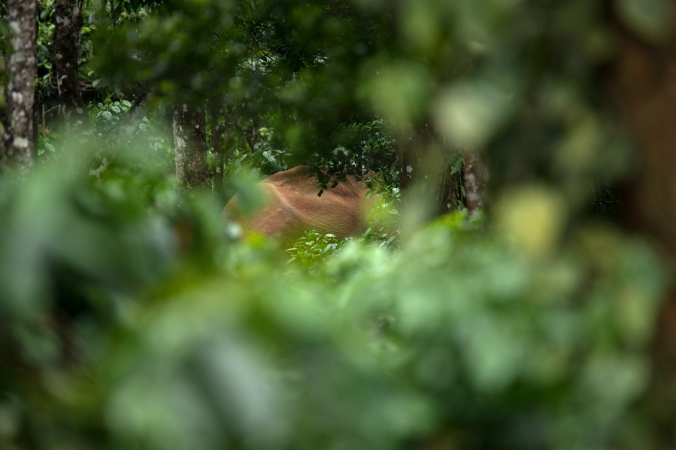
കടപ്പാട്: ഗണേശൻ രഘുനാഥൻ
ആന മൂലമുണ്ടാവുന്ന കൃഷിനാശവും ജീവഹാനിയും ആയിരത്തി തൊള്ളായിരത്തി തൊണ്ണൂറുകളുടെ ആദ്യപാദത്തോടെ മാത്രം ശ്രദ്ധയില്പെട്ടുതുടങ്ങിയ ഒന്നെന്ന് പലരും വിലയിരുത്തിയത് വിശ്വസിച്ചുതുടങ്ങിയപ്പോഴാണ് ‘പാലകാപ്യം’ എന്നൊരു പ്രാചീന ഗ്രന്ഥം വായിക്കാന് ഇടയായത്. അംഗരാജ്യത്തെ പ്രജകള് ആനകള് ഉണ്ടാക്കിയ കൃഷിനാശത്തെ കുറിച്ച് രോമപാദ മഹാരാജാവിനോട് സങ്കടം പറഞ്ഞപ്പോള് ഗൗതമനാരദാദി മുനിമാരുടെ വരപ്രകാരം ഗജഗ്രഹണം നടത്തി പ്രശ്നപരിഹാരം കണ്ടുവെന്ന് ആ പുരാണം പറയുന്നു. കാലങ്ങള്ക്കിപ്പുറം ശാസ്ത്രസാങ്കേതിക മികവോട് കൂടി കാര്യനിര്വഹണം നടത്തേണ്ട സംഗതികളൊക്കെ ഉണ്ടായിട്ടും ഇന്നും പക്ഷെ പരിഹാരം ആനപ്പിടുത്തവും നാടുകടത്തലും തന്നെ! കാലാനുസൃതമായി സാങ്കേതിക തികവുകളൊന്നും ആനയും മനുഷ്യനും തമ്മിലുള്ള സംഘര്ഷത്തിന്റെ രൂക്ഷത കുറച്ചിട്ടില്ല! എന്തായാലും ആ പ്രശ്നത്തിന്റെ ഒരു താത്വികാവലോകനമാണ് ഇവിടെ നടത്താന് ആഗ്രഹിക്കുന്നത്. ഒപ്പം പ്രശ്നപരിഹാരസാധ്യതകളിലേക്ക് ഒരെത്തിനോട്ടവും. അത് ബുദ്ധന്റെയും ജോണ് സാക്സെയുടെയും ആനയെ കാണാന് പോയ അന്ധന്മാരുടെ വീക്ഷണകോണിലൂടെ ആവാം!
കഥയിലെ ഒന്നാമന് പറയുന്നു: ആവാസവ്യവസ്ഥയുടെ നാശവും fragmentation മൂലം ഇടതൂര്ന്ന കാടുകള് ശകലങ്ങളായി വെട്ടിചുരുങ്ങുന്നതുമാണ് കാരണം.
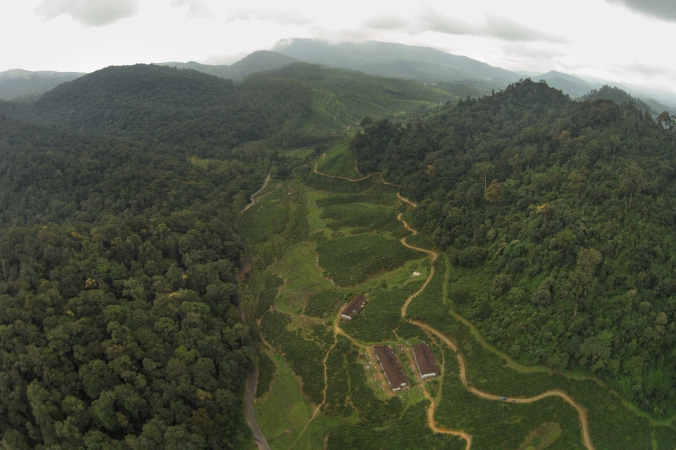
തേയിലത്തോട്ടങ്ങൾക്കായി വെട്ടിത്തെളിച്ച മഴക്കാടുകൾ ശകലങ്ങളായി വെട്ടിച്ചുരുങ്ങിയ കാഴ്ച. ആനമലയിൽ നിന്ന്. കടപ്പാട്: കല്യാൺ വർമ്മ
കാര്യം ഒരു വലിയ പരിധി വരെ ശരിയാണ്. സ്മിത്സോണിയന് ഗവേഷണ കേന്ദ്രത്തിലെ ഡോക്ടര് പീറ്റര് ലീംഗ്രബര് കണ്ടെത്തിയിട്ടുള്ളത് കഴിഞ്ഞ ചില ദശാബ്ദത്തില് ആനകള്ക്ക് നഷ്ട്ടപ്പെട്ടിരിക്കുന്നത് 50 ശതമാനത്തില് കൂടുതല് ആവാസകേന്ദ്രങ്ങളാണെന്നാണ്. തന്മൂലം തുണ്ടുകളായി വിഭജിക്കപ്പെട്ട വനശകലങ്ങളില് ചെറിയ സംഖ്യയില് ഇന്ന് ആനകളെ കണ്ടുപോരുന്നു. എന്നാല് സഹ്യനിരകളിലെ നീലഗിരിയും ആനമലയും ഇതില് നിന്നും അല്പം വ്യത്യസ്തമായി 12600 ചതുരശ്രകിലോമീറ്ററായും 6500 ചതുരശ്രകിലോമീറ്ററായും തുടര്ച്ചയായ വനമേഖലയായി ആനകള്ക്ക് കിലോമീറ്ററുകളോളം സഞ്ചരിക്കാന് ഉതകുന്ന രീതിയില് വ്യാപിച്ച് കിടക്കുന്നു. ബിലിഗിരിരംഗസ്വാമി മല മുതല് സൈലന്റ് വാലിയുമായി തൊട്ട് കിടക്കുന്ന കോയമ്പത്തൂര് വനമേഖല വരെ നീണ്ട് കിടക്കുന്ന നീലഗിരി പക്ഷെ ഊട്ടിയുടെ വിനോദസഞ്ചാരമേഖലാ വളര്ച്ചയുടെ കയ്പ്പ് നുകര്ന്ന് കൊണ്ടിരിക്കുകയാണ്; കൂനൂര്, കോത്തഗിരി, ഗൂഡലൂര്, വയനാട് എന്നിവിടങ്ങളിലെ കാടുകള് തോട്ടങ്ങള്ക്കായി വെട്ടിത്തെളിച്ച് ജനവാസകേന്ദ്രങ്ങളാക്കിയപ്പോള് ആനകളോട് പറയാനും അനുവാദം വാങ്ങാനും സര്വരും മറന്നതിനാലാകണം അവ തീറ്റയും വെള്ളവും തേടി ഇന്നും ഈയിടങ്ങള് സന്ദര്ശിച്ച് കൊണ്ടിരിക്കുന്നത്. ആദ്യമായി കണ്ണാടിയില് തന്റെ പ്രതിബിംബം കണ്ട ബുള്ബുള് പക്ഷിയെ പോലെ അമ്പരപ്പായിരുന്നുവത്രേ ആനകളെ വീട്ടുമുറ്റത്ത് കണ്ട വരത്തന്മാരായ തോട്ടക്കാര്ക്ക്. അവയെ അകറ്റിനിര്ത്താന് അവര് പയറ്റിയ സകല തന്ത്രങ്ങളും തങ്ങളുടെ വന്യബുദ്ധി ഉപയോഗിച്ച് കിഴക്കോട്ടൊഴുകുന്ന ഭവാനിയാറ്റില് ഒഴുക്കിക്കളഞ്ഞ ആനകള് പക്ഷെ, മനുഷ്യന്റെ ക്രൂരമായ പത്തൊമ്പതാമത്തെ അടവില് തോറ്റുതുടങ്ങി. തോക്കിന്കുഴലിലും വൈദ്യുതക്കമ്പികളിലും ഇന്ന് അവ തങ്ങളുടെ അന്ത്യം നേരിടുന്നു; മിച്ചമുള്ളവ അഭയാര്ഥികളായി തീരുന്നു. Elephant Refugees എന്ന് വരെ വിശേഷണങ്ങള് വീണു തുടങ്ങിയത് അങ്ങനെയാണത്രെ. സ്വന്തം കാട്ടില്നിന്ന് ആട്ടിയോടിക്കപ്പെടുന്ന ആനകള് അങ്ങനെ ആന അഭയാര്ത്ഥികളായി മാറിത്തുടങ്ങി.
അപ്പോഴാണ് നമ്മുടെ രണ്ടാമന് ചോദ്യം: ആവാസവ്യവസ്ഥയുടെ നാശമാണ് കാരണമെങ്കില് കര്ണാടകത്തിലെ ഹാസന് പോലോരിടത്ത് ആനകള് ജീവിക്കുന്നതെങ്ങനെ?
ദശഹെക്ടര് കണക്കില് മാത്രം വനമവശേഷിക്കുന്ന ആളൂര്, ആര്സിക്കെരെ, സകലേഷ്പൂര് താലൂക്കുകളില് നാല്പതോളം ആനകള് കാപ്പിത്തോട്ടങ്ങളിലും വനശകലങ്ങളിലും വര്ഷങ്ങള് തള്ളിനീക്കുന്നത് ശ്രദ്ധയില് പെട്ട രണ്ടാമന് വീ്ണ്ടും പറഞ്ഞു, ആനകളുടെ വംശവര്ദ്ധനവാണ് കാരണമെന്ന്. കാട് വിട്ട് (പ്രയോഗം രസം; പക്ഷെ കാട് വിട്ടതോ, കാട് നിന്നിടം തേടി തിരിച്ചുവന്നതോ? ഇന്നവിടെ കാടില്ലാതാക്കിയത് ആനകളല്ലെന്ന് എല്ലാവര്ക്കുമറിയാം––കേട്ട് നിന്ന മൂന്നാമൻ ആത്മഗതമുണർത്തി) പുറത്തിറങ്ങുന്ന ആനകളെ മുഴുവന് പിടികൂടണം. എത്ര ആനകളാണ് മനുഷ്യവാസസ്ഥലങ്ങള്ക്കരികെ കഴിയുന്നതെന്ന് നോക്കി, കണക്കെടുത്ത് അവയെ പൂര്ണമായി തുടച്ച് നീക്കി, പ്രശ്നത്തിന് വിരാമമിടാം. അല്ലെങ്കില് അവയെ വിരട്ടിയോടിച്ച് സമാധാനിക്കാം. വേണമെങ്കില് ആനപ്പോലീസായ താപ്പാനശ്രേഷ്ഠന്മാരുടെ സേവനം അഭ്യര്ത്ഥിക്കാം.
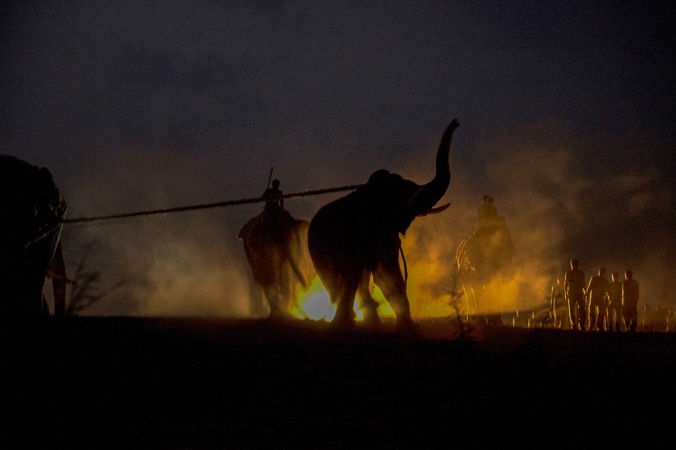
ഹാസൻ മേഖലയിൽ നടന്ന ആനപ്പിടുത്തതിൽ നിന്ന്. കടപ്പാട്: കല്യാൺ വർമ്മ
ഇതെല്ലാം കേട്ടിരുന്ന മൂന്നാമന് ചോദ്യശരമെറിയാന് തീരുമാനിച്ചു. ഇരുപത് വര്ഷക്കാലയളവില് അന്പതോളം ആനകളെ പ്രശ്നപരിഹാരമെന്നോണം പിടിച്ച് കൂട്ടിലടച്ചിട്ടും ഹാസനില് നാല്പതോളം ആനകളെങ്ങനെ വന്നു? അപ്പൊ പ്രശ്നം എണ്ണത്തില് അല്ല; സ്പില്ഓവര് പ്രഭാവമല്ലെന്ന് ഉറപ്പ് വരുത്തിയ സംതൃപ്തി മൂന്നാമന്റെ മുഖത്ത്. മാത്രമല്ല ഓടിച്ച് വിട്ടാലോ നാടുകടത്തി വിട്ടാലോ തിരികെ വരും, പൂച്ചകുഞ്ഞല്ല, ഘടാഘടിയന് ആനകളാണേയ് ! അല്ല, അനുഭവം ഉണ്ട്. ഏറെ ആനകളെ പ്രശ്നബാധിതമേഖലകളില് നിന്നും നാടുകടത്തി വിട്ട് അവ ദിവസങ്ങള്ക്കുള്ളില് തിരിച്ച് വന്ന കഥകള് ഹാസന്-കുടക് കാടുകള്ക്ക് തന്നെ പറയാനുണ്ടാവും. ഇനിയിപ്പോ ഒരിക്കലും തിരിച്ച് വരില്ലെന്ന് ഉറപ്പുള്ള സ്ഥലത്തേക്കാണെങ്കില് പ്രശ്നം മറ്റൊരു രീതിയിലാവും. വലത്തേകാലിലെ മന്ത് ഇടത്തോട്ട് മാറ്റിക്കിട്ടിയ സാക്ഷാല് നാറാണത്തിന്റെ അവസ്ഥ. പുതിയ മേഖലയിലേക്ക് ‘സ്ഥലംമാറ്റം’ കിട്ടി വന്ന ആനക്കേമന്മാരില് ഒരുവന് കടലില് ചാടിയതും നോട്ടിക്കല് മൈലുകളോളം നീന്തിയതും നാവികസേന അവനെ തിരികെ വലിച്ച് കൊണ്ട് വന്നതും, കര കേറ്റി വിട്ട് ഏതാനും ദിവസങ്ങള്ക്കകം അവന് ഒരു കിണറ്റില് വീണ് അവസാനിച്ചതും ഇന്നലെ കഴിഞ്ഞ കഥ പോലെ ഓര്ക്കുന്നു ലങ്കന് ദ്വീപ് നിവാസികള്.
എണ്ണത്തില് അല്ലെങ്കില് പിന്നെ എവിടെയാ പ്രശ്നഹേതു? ആനകള്ക്ക് പഥ്യമായ ഭക്ഷണപദാര്ത്ഥങ്ങള് വളര്ത്തുന്നതാണ് കാരണം. വാഴയും കരിമ്പും വെച്ചാല് ആനകള് തേടി വരില്ലേ? പിന്നെ വരാതിരിക്കുമോ? കാര്യം ശരി തന്നെ. വര്ഷങ്ങളോളം പരുത്തി വളര്ന്നിരുന്ന കൊങ്കുനാടന് മണ്ണുകള് കുഴല്കിണറുകളാല് ഫലഭൂയിഷ്ഠമായപ്പോള് പരുത്തിക്കാടുകള് വാഴയ്ക്കും തെങ്ങിനും കരിമ്പിനും ചോളത്തിനും വഴി മാറി. ഇവ വനയോരങ്ങള് വരെ നീണ്ടപ്പോള് അക്കേഷ്യന് മുള്ക്കാടുകളിലെ പട്ടയും പുല്ലുമാണോ തിന്നേണ്ടത് അതോ അതിനരികില് മാദകഗന്ധം പടര്ത്തി നില്ക്കുന്ന കാര്ഷിക വിളകളാണോ എന്ന് ആനകള്ക്ക് ഒരു പക്ഷെ അധികം ചിന്തിക്കേണ്ടി വന്നിട്ടുണ്ടാവില്ല. അല്പം അപായസാധ്യതകളെ തരണം ചെയ്താല് ആനുകൂല്യങ്ങള് പതിന്മടങ്ങാണ് ആനകള്ക്ക്. ഭീരുക്കളല്ല അവര്. പെരുവയര് നിറക്കാന് പാടുപെടുന്നവര്ക്ക് ഇത്തിരിപ്പോന്ന മനുഷ്യരുടെ ചെറുത്തുനില്പ്പുകളെ, അവരുടെ ദുര്ബലമായ കരങ്ങള്കൊണ്ടുള്ള പടക്കമേറുകളെ ഏറെക്കാലം ഭയന്ന് പിന്മാറാനുമാകില്ല!
“ഹിപ്പോക്കാമ്പ്സും സെറിബെല്ലവും ഇതര മസ്തിഷ്കഘടനകളും മനുഷ്യരുടേതിന് സമമായ ആനകളുടെ ദൈനംദിന കാര്യങ്ങള് തീരുമാനിക്കുന്നത് ഇത്തരം സിദ്ധാന്തം മാത്രമാവില്ല.” ഉയര്ന്നു കേട്ട ഈ ശബ്ദം പാതിമയക്കം വിട്ടുണര്ന്ന നാലാമന്റേതായിരുന്നു. ആത്യന്തികമായി സാമൂഹ്യ ജീവിയായ ആനകളില് തലമുറകളിലേക്ക് അറിവ് പകര്ന്ന് കൊടുക്കുന്ന ശീലമുള്ളതിനാല് മുന്കാലങ്ങളില് ആ സ്ഥലത്ത് കൂടെ സഞ്ചരിച്ച ഓര്മയുടെ പുറത്താണ് ഇന്ന് നഗരങ്ങളായി മാറിയ പലയിടത്തും കാട്ടാനകളെ കണ്ടുവരുന്നതത്രെ. ജോയ്സ് പൂളും സിന്തിയ മോസും ഡഗ്ലസ് ഹാമില്ട്ടണും മൈക്ക് ചേസും ഇത്തരത്തില് ആനകള് അറിവ് തലമുറകളിലേക്ക് പകരുന്നതിനെ കുറിച്ചും അവയുടെ ദീര്ഘദൂര സഞ്ചാരത്തെക്കുറിച്ചും അവയുടെ സ്ഥിര വാസമേഖലയോടുള്ള വിശ്വാസ്യത അഥവാ fidelityയെ കുറിച്ചും മനോഹര ലേഖനങ്ങള് കഴിഞ്ഞ മൂന്നര പതിറ്റാണ്ടിനിടയ്ക്ക് എഴുതിയിട്ടുണ്ട്. ‘കര്ണാടകത്തിലെ തുംകൂറിലെ വയലുകളിലും വയനാടടുത്ത് പനമരത്തെ കാപ്പി തോട്ടങ്ങളിലും തെക്കന് ശ്രീലങ്കയിലെ തിസ്സമഹാരമയിലെ മാലിന്യക്കൂമ്പാരങ്ങള്ക്കിടയിലും ആനകള് കണ്ട് വരുന്നത് അത് മൂലമാവണം. കൈയിലുള്ള പത്രം നാലായി മടക്കി ഒന്നാം പേജിലെ ചിത്രം കാണിച്ചു, നാലാമന്റെ തുണക്കാരനൊരാള്. എന്താണതില്? കിലോമീറ്ററുകള് സഞ്ചരിച്ച്, കവിഭാവനകളില് ഉള്പുളകമുണര്ത്തുന്ന കാഴ്ചയൊരുക്കി നിളാനദിയില് നീരാടുകയായിരുന്ന മൂന്ന് കരിവീരശ്രേഷ്ഠന്മാരുടെ ചിത്രം. പറയെടുപ്പിന് വന്ന ആനകളെന്ന് കരുതി അവയെ അരിയും പൂവുമെറിഞ്ഞ് ഫലങ്ങള് നല്കി സ്വീകരിച്ചവര് വരെയുണ്ടത്രേ, വള്ളുവനാടന് ഗ്രാമങ്ങളില്! അലപം തമാശ കൂട്ടിച്ചേര്ത്തു നമ്മുടെ ഉത്സാഹഭരിതനായ തുണക്കാരന്.
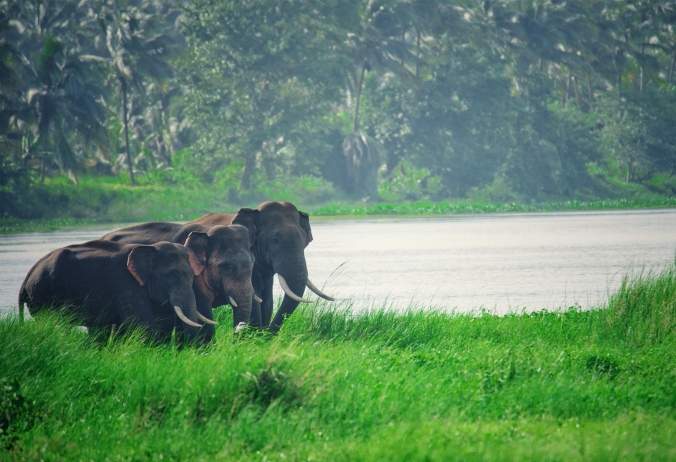
നിളാതീരത്ത് മേയുന്ന കാട്ടാനകൾ. കടപ്പാട്: അനീഷ് എസ്
ഈ അഭിപ്രായങ്ങളോടൊന്നും യോജിക്കാത്ത കണക്കെ നിന്ന അഞ്ചാമന് പക്ഷെ ഉരിയാടിയപ്പോള് അവന് പറഞ്ഞത് ശരിയാണെന്ന് തോന്നി മറ്റുള്ളവര്ക്കെല്ലാം. ‘അതാത് സ്ഥലങ്ങളില് ആ പ്രദേശത്തിന്റെ പ്രശ്നം മനസ്സിലാക്കി സംഘര്ഷ സാഹചര്യങ്ങള്, വിശേഷാല് മനുഷ്യ ജീവഹാനി ഏത് രീതിയില് സംഭവിക്കാന് സാധ്യതയുണ്ടോ എന്ന മനസ്സിലാക്കി അത് ഏതെങ്കിലും രീതിയില് തടയാന് ഒരുപാധി ഏര്പ്പെടുത്തിയാല് പ്രശ്നപരിഹാരം ഒരളവുവരെ സാധ്യമാവും. പക്ഷേ യഥാര്ത്ഥ പ്രശ്നം അതല്ല. എന്ത് പദ്ധതികള് ആസുത്രണം ചെയ്താലും അത് സര്ക്കാരിന്റെയും ഫോറസ്റ്റ് ഉദ്യോഗസ്ഥരുടെയും ചുമതലയും കടമയുമാണെന്ന് കരുതി യാതൊരു ഉത്തരവാദിത്തവും കാണിക്കാന് ആ മേഖലയിലെ ജനങ്ങള് തയ്യാറാവാത്തിടത്തോളം കാലം അവ പരാജയപ്പെട്ട് കൊണ്ടിരിക്കും. “കൂട്ടായ പരിശ്രമം കൊണ്ട് മാത്രമേ ഈ വിഷയത്തിന് ഒരു പരിഹാരം സാധിക്കുകയുള്ളൂ”, നമ്മുടെ അഞ്ചാമന്റെ ശബ്ദത്തില് അനുഭവസമ്പത്ത് പകര്ന്ന് നല്കിയ ആത്മവിശ്വാസം നിഴലിക്കുന്നുണ്ടായിരുന്നു.
പറഞ്ഞ കാര്യങ്ങള് വളരെ ശരിയാണ്––ഇത്തരത്തില് പ്രശ്നങ്ങള് മനസ്സിലാക്കിയത് മൂലം പശ്ചിമഘട്ടത്തിലെ ആനമലക്കാടുകളുടെ മധ്യഭാഗത്തായി സ്ഥിതി ചെയ്യുന്ന വാല്പ്പാറയിലെ തോട്ടം മേഖലയില് കഴിഞ്ഞ ചില വര്ഷങ്ങളായി സംഘര്ഷബാധിത പ്രദേശങ്ങളുടെ എണ്ണവും ആനകള് മൂലം വീടുകള്ക്കും മറ്റുമുണ്ടാവുന്ന നാശനഷ്ടങ്ങളും കുറയുന്നതായി കണ്ടുതുടങ്ങിയിരിക്കുന്നു. ആനകളുടെ നീക്കങ്ങളെക്കുറിച്ചുള്ള, ‘മുന്നറിയിപ്പ് സംവിധാനം’ എന്ന പേരില് അറിയപ്പെടുന്ന ഒരു പറ്റം സാങ്കേതിക ഉപാധികള് പ്രശ്നപരിഹാരത്തിന് വലിയ രീതിയില് ഉതകുന്നുണ്ടെങ്കിലും പരിശ്രമങ്ങളുടെ വിജയകാരണം പക്ഷേ അതല്ല! വര്ഷങ്ങളെടുത്ത് അവിടുത്തെ സാഹചര്യങ്ങളെ ആഴത്തില്, ശാസ്ത്രീയമായി മനസ്സിലാക്കിയ പഠനങ്ങളാണ് യഥാര്ത്ഥത്തില് വിജയിച്ചുകൊണ്ടിരിക്കുന്നത്. ആ പഠനങ്ങള്ക്കായി ജീവന് പണയം വെച്ച് മുന്നിട്ടിറങ്ങിയ ശാസ്ത്രജ്ഞരുടെ ഉദ്യമങ്ങളാണ് ജനങ്ങളെയും ആനകളെയും പരസപരം കൊന്നൊടുക്കാതെ ജീവിക്കാന് ഇന്ന് പ്രേരിപ്പിക്കുന്നത്!

രണ്ടു കിലോമീറ്റർ ചുറ്റളവിൽ ഉള്ള പ്രദേശങ്ങളിൽ നിന്നും കാണുന്ന രീതിയിൽ സ്ഥാപിക്കപ്പെട്ടിട്ടുള്ള ചുവന്ന വിളക്ക് ആ പ്രദേശത്തെ ആനകളുടെ സാന്നിധ്യത്തെ കുറിക്കുന്നു. വാൽപ്പാറയിലെ മുന്നറിയിപ്പ് സംവിധാനങ്ങളിൽ ഒന്ന്. കടപ്പാട്: സ്റ്റുവർട്ട് ഡൺ
സമാനരീതിയില് ശ്രീലങ്കയുടെ വടക്കന് മേഖലകളില് ഗാല്ഗാമുവാ, വാസ്ഗാമുവ തുടങ്ങിയ സ്ഥലങ്ങളില് ഗജശാസ്ത്രജ്ഞന് ഡോക്ടര് പൃത്വിരാജ് ഫെര്ണാണ്ടോയുടെ പ്രകൃതി സംരക്ഷണ ഗവേഷണ കേന്ദ്രത്തിന്റെ നേതൃത്വത്തില് പ്രാദേശിക സമിതികള് രൂപീകരിച്ച് സംഘര്ങ്ങള് ലഘൂകരിക്കുകയുണ്ടായി. ഇവിടെ പക്ഷേ വൈദ്യുത വേലികള് സ്ഥാപിച്ചാണ് കാര്യങ്ങള് നിയന്ത്രണത്തിലാക്കിയത്. വൈദ്യുതി വേലികളുടെ പരിപാലനം പൂര്ണമായും മേല്പ്പറഞ്ഞ പ്രാദേശിക സമിതികളുടെ മേല്നോട്ടത്തിലായതിനാല് നോട്ടക്കുറവോ പിഴവോ വരുന്നില്ലെന്ന് മാത്രമല്ല, ഈ ഉദ്യമം പതുക്കെ സുസ്ഥിരമാകുവാനും തുടങ്ങി. വൈദ്യുത വേലികള്കൊണ്ട് അനുകൂലഫലം കാണുകയില്ല എന്ന മുന്ധാരണ കൊണ്ട് നടക്കുന്നവര് ഇവിടെ വരെ പോയി അത് കാണണം. വേലിയുടെ പക്കല് വരെ നീളുന്ന ആനകളുടെ കാല്പ്പാടുകള് അവിടെ നിന്നും വഴി മാറി തിരിച്ച് പോന്നിരിക്കുന്നതായി കാണാം.
അല്പം വൈകിയെത്തിയത് കാരണം ചര്ച്ചയില്, അഥവാ സംവാദത്തില് പങ്കെടുക്കാതെ അല്പമകലെ മാറി നിന്ന് എല്ലാം കേള്ക്കുകയായിരുന്നു ആറാമനായ കൃഷ്ണന്. അത് നന്നായെന്ന് തോന്നി––ഒട്ടും വൈകിക്കാതെ തിരിച്ച് നടത്തം തുടങ്ങി. വന്ന വേഗതയില്ല പക്ഷെ; മനസ്സ് നിറയെ ചിന്തകള് നിറഞ്ഞിരിക്കുന്നു ഇപ്പോള്. ആനയെന്നാല് നാല് തൂണ് പോലുള്ള കാലുകളും ചൂല് കണക്കെ വാലും മുറം പോലുള്ള ചെവികളും തുമ്പിക്കൈയും എല്ലാംകൂടി സമ്മിശ്രമായ ഒരു ആജാനുബാഹുവായ, ഗാംഭീര്യത്തികവാര്ന്ന, സര്വ്വോപരി സങ്കീര്ണതകള് നിറഞ്ഞ ഒരു മഹാത്ഭുതമാണെന്ന് മനസ്സിലാക്കാന് ഏതായാലും കൃഷ്ണന് പിന്നെ വലിയ ബുദ്ധിമുട്ടുണ്ടായില്ല. ഈ വീക്ഷണങ്ങള്, കൃഷ്ണനില് അന്ധനാണെങ്കിലും പുതിയ ചിന്തകളും വെളിപാടുകളുമുണര്ത്തി. കൃതയുഗത്തില് ഭദ്രനായും ത്രേതായുഗത്തില് മന്ദനായും ദ്വാപരയുഗത്തില് മൃഗമായും കലിയുഗത്തില് ഭദ്രമന്ദമൃഗ ജാതികളുടെ സമ്മിശ്രമായ ആനകളായും ജന്മമെടുത്ത, ഏതു തരത്തിലുള്ള സാഹചര്യവുമായും എളുപ്പം പൊരുത്തപ്പെടാന് പോന്ന, highly adaptable എന്ന് തീര്ത്തും വിശേഷിപ്പിക്കാവുന്ന ആനകളെ കൂടുതലായി ജനവാസകേന്ദ്രങ്ങളില് നിന്നകലെയല്ലാതെ കാണാന് സാധിക്കും, കാടും നാടും തമ്മിലുള്ള അന്തരം കുറഞ്ഞുവരുമ്പോല് ആനകള് നാട് കാടായും മനുഷ്യന് കാട് നാടായും കണ്ടുതുടങ്ങും. വരും നാളുകളില് ഏറെയുണ്ടാകാന് സാധ്യതയുള്ള അത്തരം സന്ദര്ഭങ്ങളില്, കാട്ടാനയും മനുഷ്യനും തമ്മിലുള്ള നിരന്തരമായ കൂടിക്കാഴ്ചകളില് അപകടമില്ലാതിരിക്കാന് തയ്യാറെടുക്കുക എന്നതാണ് പ്രധാനം. ആനകളെക്കാള് അക്കാര്യത്തില് ഏറെ ചെയ്യാന് സാധിക്കുക മനുഷ്യനാണ്. ഇനി നേരിടാന് പോകുന്ന അപ്രതീക്ഷതമായ മുഖാമുഖങ്ങളില് ആസൂത്രിത നീക്കങ്ങളും തയാറെടുപ്പുകളും ഇരുഭാഗത്തെയും മാനസിക, ശാരീരികാഘാതങ്ങളെ ചെറുക്കാന് സഹായിച്ചേക്കും. സംഘര്ഷം എന്ന് ജനസഹസ്രങ്ങളും മാധ്യമങ്ങളും ഉദ്ഘോഷിക്കുന്ന ആ ‘വന്യസന്ദര്ശനങ്ങളെ’ ഒരു സൗഹൃദസന്ദര്ശനമായി കണക്കാക്കി വിരുന്നുകാരെ മനസ്സുവിഷമിപ്പിക്കാതെയും ശരീരത്തിന് പരിക്കേല്ക്കാതെയും തിരിച്ചയക്കാനുള്ള പക്വത നേടാന് മനുഷ്യരെ പ്രാപ്തരാക്കുക എന്ന ലക്ഷ്യം നിറവേറ്റാനായിരിക്കണം അധികാരവർഗ്ഗത്തിന്റെ ആത്മാര്ത്ഥമായ ശ്രമങ്ങളത്രയും.
ഏറെക്കാലത്തെ പരിശ്രമം കൊണ്ട് നേടിയ അറിവുകളിൽ നിന്നും, അനുഭവങ്ങൾ നൽകിയ ബാലപാഠങ്ങളിൽ നിന്നും അടർത്തിയെടുത്ത ഏടുകൾ മനസ്സിൽ ഒന്നൊന്നായി മറിയവേ, തെല്ലകലെയല്ലാത്ത സഹവർത്തിത്വ നാളുകൾ സ്വപ്നം കണ്ട് കൃഷ്ണൻ നടന്നകന്നു.
****************************
കുറിപ്പ്: ഒക്ടോബർ ലക്കം “കൂട്” മാസികയിൽ വന്ന ലേഖനത്തിന്റെ പുനഃപ്രസിദ്ധീകരണം. ഡ്രാഫ്ട് പരിശോധിച്ചതിന് പ്രസന്ന വർമ്മ, പ്രസാദ് രാമചന്ദ്രൻ എന്നിവരോട് കടപ്പാട് രേഖപ്പെടുത്തിക്കൊള്ളുന്നു.
പാലകാപ്യന് ചിന്തകളും സമകാലീന ഗജസംരക്ഷണവും പരിപാലനവും
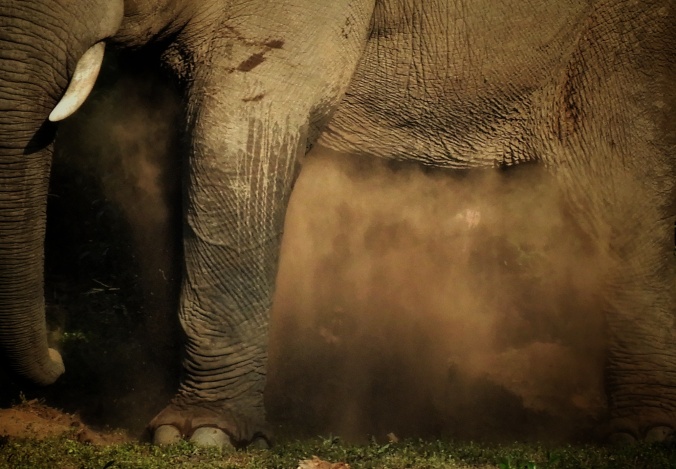
വന്യാസ്തത്ര സുഖോഷിതാ വിധി വശാദ്
ഗ്രാമാവതീര്ണാ ഗജാ
ബദ്ധാസതീക്ഷ്ണകടുഗ്രവാഗ്ഭിരതിശുഗ്
ഭീമോഹബന്ധാദിഭി:
ഉദ്വിഗ്നാശ്ച മന:ശരീരജനിതൈര്
ദുഃഖൈരതീവാക്ഷമാ:
പ്രാണാന് ധാരയിതും ചിരം നരവശം
പ്രാപ്ത: സ്വയൂഥാദഥ.
കാട്ടിൽ തങ്ങളുടെ ആവാസവ്യവസ്ഥയിൽ സുഖലോലുപരായി കഴിഞ്ഞിരുന്ന ആനകൾ വിധിവശാൽ ഗ്രാമത്തിലെത്തി, കടുപ്പവും അത്യുഗ്രവുമായ വാക്കുകളാലും, ഭയം, ബന്ധനം എന്നിവയാലും, സ്വജനവിരഹത്താലും, മനസിനും, ശരീരത്തിനും ക്ലേശം വന്ന് അക്ഷമരായി, പ്രാണൻ നിലനിർത്താൻ ചിരകാലം മനുഷ്യരുടെ അധീനതയിൽ വസിക്കേണ്ടതായി വരുന്നു.
മാതംഗലീല. ഗജരക്ഷാദിവിചാരം ശ്ലോ.1
തർജ്ജമ കടപ്പാട്: ചെറുവള്ളി നാരായണൻ നമ്പൂതിരിയുടെ മാതംഗലീല
ഇപ്രകാരമാകുന്നു നീലകണ്ഠവചനം. നൂറ്റാണ്ടുകള്ക്കു മുന്നേ മാതംഗലീലാകാരന് പാലകാപ്യവചനങ്ങളെ കോര്ത്തിണക്കി, രോമപാദപാലകാപ്യ സംവാദങ്ങള് സാരാംശമാക്കി, പദ്യരൂപത്തില് ലീല രചിച്ചപ്പോള് മേല്പ്പറഞ്ഞ വരികള് പില്ക്കാലത്ത് ഇത്ര കണ്ടു പ്രസക്തമാകുമെന്ന്് കരുതിക്കാണില്ല!
ഭദ്രമന്ദമൃഗങ്ങളുടെ സങ്കീര്ണമായി പാലകാപ്യന് വിവരിക്കുന്ന ഗജങ്ങള് (നമ്മുടെ ആനകള് തന്നെ) മനുഷ്യനുമായി ഇടകലര്ന്ന് ജീവിക്കേണ്ടിവരുന്ന കലികാലത്തില് സംഘര്ഷങ്ങളും ഏറുകയാണ്. നാട്ടിലും കാട്ടിലും അനുദിനം വര്ധിച്ചു വരുന്ന ആനക്കലാപങ്ങള് ഒരു കലിയുഗ പാലകാപ്യന്റെ അസാന്നിധ്യത്തിന്റെ അനന്തരഫലം തന്നെയാണ്.
ഹസ്തിയൂഥങ്ങളുടെ സഞ്ചാരപഥങ്ങള് കാര്ന്നു തിന്നുന്ന വികസന പദ്ധതികളും മനുഷ്യരാശിയുടെ അമിതമായ ഭൂ ഉപയോഗവും ഉപഭോഗവും കാരണം കാട്ടില് സസന്തോഷം വിഹരിക്കുന്ന ആനക്കൂട്ടങ്ങള്ക്ക് അവരുടെ ഇടം നഷ്ടപ്പെട്ടുകൊണ്ടിരിക്കുകയാണ്. ആനയും മനുഷ്യനും തമ്മിലുള്ള സംഘര്ഷം ഏറെ വര്ധിച്ചുവരുന്ന ഈ കാലഘട്ടത്തിലും പ്രസ്തുതപ്രശ്നത്തിലെ പ്രശ്നപരിഹാര സാധ്യതകള് കഴിഞ്ഞ ശതാബ്ദത്തില് രോമപാദന് ദീര്ഘവീക്ഷണം ചെയ്തതില് നിന്നും ഒട്ടും വ്യത്യസ്തം അല്ലെന്നുള്ളതാണ് സത്യം.
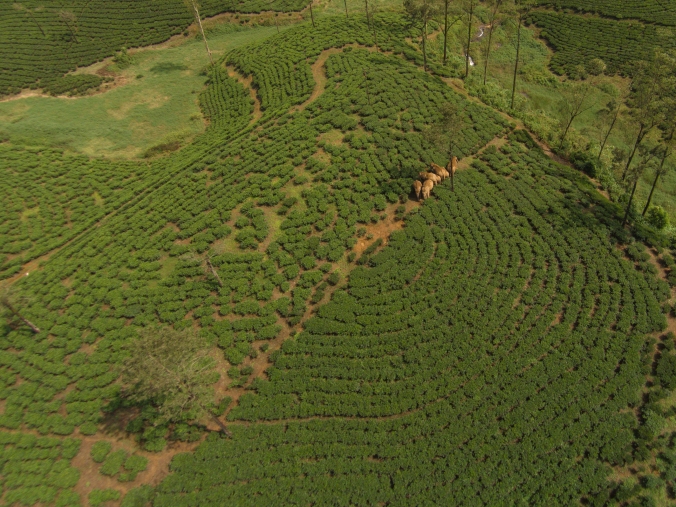
മഴക്കാടുകൾ തോട്ടങ്ങൾക്ക് വഴി മാറിയപ്പോൾ ഇല്ലാതായത് കാട്ടാനക്കൂട്ടങ്ങളുടെ സഞ്ചാരപഥങ്ങളാണ്. ചിത്രം കടപ്പാട്: കല്യാൺ വർമ്മ
അംഗരാജ്യാധിപന് ഭടന്മാരെ വിട്ട് പ്രജകള്ക്ക് ക്ലേശം സൃഷ്ടിച്ചിരുന്ന ആനകളെ പിടികൂടി ഗൗതമനാരദാദി മുനിമാരെ ഏല്പ്പിച്ചപ്പോള് മന:സന്താപത്താല് അലഞ്ഞ പാലകാപ്യന് ഇന്നലെയുടെ ചിത്രം. ആനത്താരകളും ആവാസവ്യവസ്ഥകളും ദിനംപ്രതി നശിക്കുന്ന ഇന്ന് പക്ഷെ ആനകള് കൃഷിനാശത്തിന്റെ ഇരയാവുന്നവരുടെ തോക്കിന്കുഴലിലും, വൈദ്യുത കമ്പികളിലും പിടഞ്ഞു ചിന്നം വിളിയോടെ പ്രാണന് വെടിയുമ്പോള് അവയുടെ നിലവിളിക്കൊപ്പം മറ്റ് ശബ്ദകോലാഹലങ്ങളും നിലയ്ക്കുകയാണ്. ദുഃഖാചരണങ്ങളില്ല; പ്രക്ഷോഭങ്ങളോ തീവ്രമായപ്രതിഷേധസ്വരങ്ങളോ ഇല്ല, ഉള്ള ദുര്ബലപ്രതിഷേധങ്ങളാകട്ടെ ഫെയ്സ്ബുക്കിന്റെ ചുവരുകളില് ഒടുങ്ങി തീരുന്നത് ഗുണമൊട്ടു ചെയ്യുന്നുമില്ല. വെടിവെച്ചുകൊല്ലല് കഴിഞ്ഞാല് മനുഷ്യകുലവുമായുള്ള സംഘര്ഷാവസ്ഥ പരിഹരിക്കാനുള്ള ഒറ്റ മൂലിയിപ്പോഴും നാടുകടത്തലാണ്. ഇതിനായി പിടിക്കപ്പെടുന്ന, കാടുമാത്രം കണ്ട് ശീലിച്ച സ്വതന്ത്രരായ കാട്ടാനകള് പന്തികളിലെ തേക്കിന് കഴകളില് തലയിടിച്ചും മുഖം ചായ്ച്ച് വിലപിച്ചും സ്വാഭാവികമായസംഘര്ഷം നടത്തുമ്പോള് അവരുടെ ആരോഗ്യവും ജീവനും തന്നെ അപകടത്തിലാകുന്നു.
ചട്ടങ്ങള് പഠിപ്പിക്കുന്ന കാടരുടെയും കുറുബരുടെയും ഇടയ്ക്കിടെയുള്ള സാന്ത്വന ശബ്ദങ്ങളും കരിമ്പിന് തുണ്ടിന്റെയോ ശര്ക്കരയുടെയോ മധുരവും മാത്രമാണ് പീഡനത്തിനിടയില് അവന് ലഭിക്കുന്ന ആശ്വാസം. ആ മധുരത്തിന്റെ സാന്ത്വനത്തിലും കാടിന്റെ വിളി അവനില് നിന്നും ഒരിക്കലും മാഞ്ഞ് പോകില്ല! എങ്കിലും ബന്ധനമെന്ന യാഥാര്ത്ഥ്യവുമായി മറ്റ് നിവര്ത്തിയില്ലാത്തതിനാല് അവന് പൊരുത്തപ്പെടുന്നു. മാസങ്ങള്ക്കൊടുവില് കാട് കൈവിട്ട കൊമ്പന് പന്തിയില് നിന്നും വനവ്യഥകളുമായി പുറത്തിറങ്ങുമ്പോള് അവന് പുതിയ പേരും ചാര്ത്തി കൊടുത്ത് പുതിയ ചുമതലകളിലേക്ക് പറഞ്ഞു വിടുകയായി; തുണയ്ക്ക് ഇരുവശവും കോലേന്തിയ കൃശഗാത്രര്. കാട്ടുകൊമ്പന് പിന്നെ ഒരു ജോലിക്കാരനായി, ഉദ്യോഗസ്ഥനായി അവര് എല്പ്പിക്കുന്ന ചുമതലകള് നിറവേറ്റ്ി മരണം വരെ മനുഷ്യരോടൊപ്പം ജീവിക്കുന്നു.
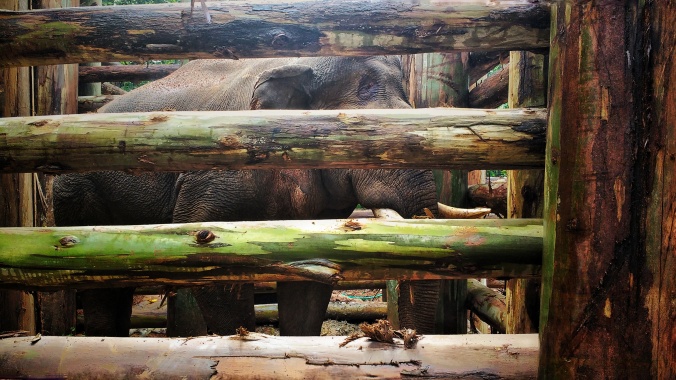
സംരക്ഷണവിഷമവൃത്തങ്ങള്
രാജ്യഭ്രഷ്ടനായ രാജാവിന് സമനത്രെ വനവിരഹിതനായ കളഭവും. സാമൂഹ്യജീവിതം നയിക്കുന്ന മൃഗങ്ങളില് ഏറ്റവും സങ്കീര്ണ്ണമായ സമ്പര്ക്ക രീതികള് കണ്ടു വരുന്ന ആനകള് മൃഗരാജവര്ഗ്ഗത്തില് നിന്നും വ്യത്യസ്തമായി സ്ത്രീമേധാവിത്വ സമൂഹമാകുന്നു. ഇന്ന് കണ്ടു വരുന്ന മൂന്ന് ഗജവര്ഗങ്ങളില് ആഫ്രിക്കന് ആനകളുടെ കാര്യത്തില് ഇത് വളരെ പ്രകടമാണ്. മെട്രിയാര്ക്ക് (matriarch) എന്ന് വിളിക്കപ്പെടുന്ന കൂട്ടത്തിലെ മുതിര്ന്ന പിടിയാനയുടെ നിര്ദേശങ്ങള്ക്കും കല്പനകള്ക്കും ആജ്ഞാനുവര്ത്തികളായി മറ്റു മുതിര്ന്നവരും കുട്ടികളും അടങ്ങുന്ന ആനകുടുംബങ്ങള് (Family units and herds) വാഴുന്നു. ഇതില് നിന്നും അല്പം വ്യത്യസ്തമായി ഏഷ്യന് ആനകള് കുറേക്കൂടെ കുറഞ്ഞ അധികാരശ്രേണി (Hierarchy) പ്രകടമാക്കുന്നവയാണെന്ന് അടുത്തിടെയായി നടന്നു വരുന്ന (ലേഖകന്റെ നിരീക്ഷണങ്ങള് ഉള്പ്പെടെ) പഠനങ്ങള് വിലയിരുത്തുന്നു. ഏഷ്യന് ആനകളില് കൂട്ടത്തിലെ ഓരോ പിടിയാനയ്ക്കും തന്റേതായ പങ്കും പ്രാധാന്യവും ഉണ്ടെന്ന് സാരം. ഇതേ കുറിച്ച് കൂടുതല് വിവരങ്ങള് ഇതേ പ്രസിദ്ധീകരണത്തിലെ മറ്റു ചില ലേഖനങ്ങളില് കാണാവുന്നതാണ്.
യൗവനാരംഭത്തില് കൂട്ടത്തില് നിന്നും നീങ്ങി പുതിയ സഞ്ചാരപഥങ്ങള് തേടുന്ന കൊമ്പന്മാര് പിന്നീട് കൂട്ടം ചേരാതെ മറ്റു കൊമ്പന്മാരൊത്ത് ബാച്ചിലര് ഗ്രൂപ്പുകളിലോ (Bachelor Group) ഒറ്റയ്ക്കോ കാലം കഴിച്ചുകൂട്ടുന്നു. തന്നെക്കാള് മുതിര്ന്ന കൊമ്പന്മാര് അടങ്ങുന്ന ബാച്ചലര് ഗ്രൂപ്പുകളില് നിന്നും ആ പ്രദേശത്തെ കുറിച്ചും, ആനത്താരകളെ കുറിച്ചും മനസിലാക്കുന്ന ഗജയുവാക്കള് കാലക്രമേണ തങ്ങളുടെ ഹോം റേഞ്ച് (Home Range) സ്ഥാപിക്കുകയും ചെയുന്നു. മുതിര്ന്ന കൊമ്പന്മാരുടെ അഭാവത്തില് (കൊമ്പിനുവേണ്ടിയുള്ള വലിയ തോതിലുള്ള വേട്ട കാരണവും, വര്ധിച്ച ആനകളുടെ എണ്ണം നിയന്ത്രിക്കാനായി ചെയ്ത സെലക്ഷന് കില്ലിംഗിലൂടെയും ആഫ്രിക്കയിലെ പല ഭാഗങ്ങളിലും ഇങ്ങനെ മുതിര്ന്ന കൊമ്പനാനകള്ക്ക് ഏറെക്കുറെ ഇല്ലാതായി) യൗവനം കടക്കുന്ന കുട്ടിക്കൊമ്പന്മാര്, അറിവില്ലായ്മ മൂലവും മാനുഷികസമര്ദ്ദങ്ങള് ഏല്പ്പിക്കുന്ന ആഘാതങ്ങളുടെ ഫലമായും അക്രമവാസന നിറഞ്ഞവരും, ക്രൂരവും വികൃതവുമായ പല സ്വഭാവപ്രതിഭാസങ്ങള് ഉള്ളവരായും മാറുന്നതായി കണ്ടെത്തിയിട്ടുണ്ട്. ആഫ്രിക്കന് ആനകള് ഒരു കൂട്ടം കാണ്ടാമൃഗങ്ങളെ വക വരുത്തിയ സംഭവം ശാസ്ത്ര/വന്യജീവി സംരക്ഷണ ലോകത്തെ ഏറെ ഞെട്ടിച്ച, കുപ്രസിദ്ധിയാര്ജ്ജിച്ച ഒരു സംഭവമായിരുന്നു. അതുവരെ കേട്ടുകള്വി പോലുമില്ലാത്ത ആക്രമണമായിരുന്നു അത്. അത്തരം ആഘാതം ഏര്പ്പെട്ട മേഖലകളിലെ ആനക്കൂട്ടങ്ങളിലെ മനഃശാസ്ത്രപരമായ വ്യതിയാനങ്ങള് അവയുടെ പെരുമാറ്റ രീതികളില് /ശാരീരികമായ പ്രക്രിയകളിലും വലിയ തോതില് ദോഷകരമായ മാറ്റം വരുത്തുന്നതായി പടിഞ്ഞാറന് പഠനങ്ങള് തുറന്നു കാട്ടിയിട്ടുണ്ട്. കൃഷിനാശത്തിന് പ്രശ്നപരിഹാരമെന്നോണം വന് തോതില് യാതൊരു വ്യവസ്ഥയും കൂടാതെ കാട്ടാനകളെ പിടി കൂടി നാടുകടത്തുമ്പോഴും മെരുക്കിയെടുക്കാന് ശ്രമിക്കുമ്പോളും ഈ അറിവുകളെല്ലാം സൗകര്യപൂര്വം മറക്കപ്പെടുന്നു.
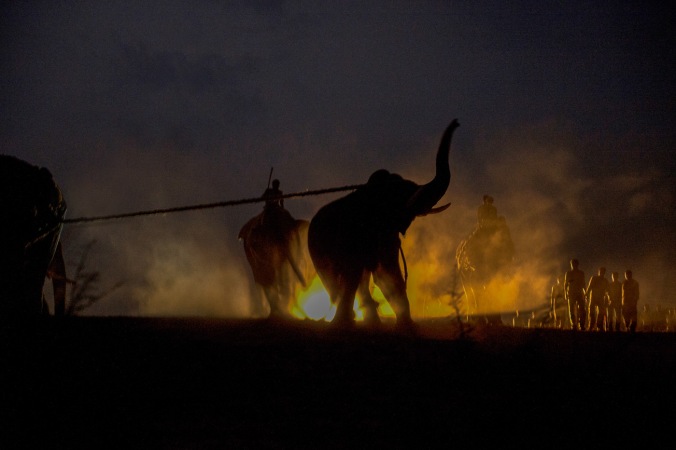
നാട് കടത്തൽ ഒരു ഉപായമല്ല എന്നും, അത് ഒരു സ്ഥലത്തെ പ്രശ്നങ്ങളെ മറ്റൊരു സ്ഥലത്തേക്ക് മാറ്റുക മാത്രമാണ് ചെയ്യുന്നതെന്നും പഠനങ്ങൾ ചൂണ്ടിക്കാട്ടിയിട്ടുണ്ട്.
ചിത്രം കടപ്പാട്: കല്യാൺ വർമ്മ
മനുഷ്യരുടേതിന് സമാനമായ ചില ശാരീരിക/മാനസിക പ്രക്രിയകള് കണ്ടു വരുന്ന ആനകളില് ബാഹ്യമായ ആഘാതങ്ങള് വന് തോതില് സമ്മര്ദ്ദം (stress) ഉണ്ടാക്കുമെന്ന് ഇരു വന്കരകളിലെയും പഠനങ്ങള് കണ്ടെത്തിയിട്ടുണ്ട് (ലേഖകന്റേത് ഉള്പ്പെടെ). ഇത്തരം സമ്മര്ദ്ദങ്ങള് പിടിയാനകളിലെ ഈസ്ട്രജന് ഹോര്മോണ് ഉല്പ്പാദനത്തെയും പ്രജനന ശേഷിയെയും സാരമായി ബാധിച്ചേക്കാം. ആനകളുടെ സങ്കീര്ണമായ ശാരീരിക പ്രകൃതികാരണം ചെറിയ തോതില് ഉള്ള ആഘാതങ്ങള് പോലും സുപ്രധാനമായ ചില ശാരീരികപ്രക്രിയകളെ ചോദ്യം ചെയ്തെന്നിരിക്കാം. കാര്യങ്ങള് ഇതായിരിക്കെ മനുഷ്യവന്യജീവി സംഘര്ഷ പരിഹാരമായി ആനകളെ പിടികൂടുകയോ സ്ഥലം മാറ്റുകയോ (Translocate) ചെയുമ്പോള് അവശ്യമായ പരിഗണന നല്കാനാകുന്നില്ലെന്നത് തീര്ത്തും വ്യസനകരമായ കാര്യം. അടുത്തിടെ തമിഴ്നാട്ടില് പിടികൂടിയ ഒരു കൊമ്പന് ആനക്കൊട്ടിലില് കിടന്ന് ചെരിഞ്ഞതും ശ്രീലങ്കയിലെ പ്രശ്നബാധിത പ്രദേശത്തു നിന്നും സ്ഥലം മാറ്റിയ ഒരു കൊമ്പന് കടലില് ചാടിയതും, മറ്റൊരു പ്രശ്നബാധിത മേഖലയില് നിന്നും സ്ഥാനം മാറ്റിയ ഒരു പിടിയാന പുതിയ സ്ഥലത്തെ ആനക്കൂട്ടവുമായി ഉള്ള ഇടപെടലുകള്ക്കിടയിലെ സംഘര്ഷങ്ങള്ക്കിടയില് പട്ടിണി മൂലം ചെരിഞ്ഞതും മേല്പ്പറഞ്ഞ കാര്യങ്ങളെ സാക്ഷ്യപ്പെടുത്തുന്നു.
ആനകളുടെ എണ്ണത്തില് വര്ദ്ധനവുണ്ട് എന്നാണ് പുതിയ അറിവുകളെല്ലാം പങ്കുവെക്കുന്ന കാര്യം. എന്നാല് ആനകള് വംശവര്ധന നേടി എന്ന് ഉദ്ഘോഷിക്കുകയല്ലാതെ അവയുടെ യഥാര്ത്ഥ എണ്ണം ഇന്നും ഒരുവിധം ഏഷ്യന് രാജ്യങ്ങളില് ഒന്നിനും നിശ്ചയമില്ല. ആനകള് വിയറ്റ്നാം, കംബോഡിയാ തുടങ്ങിയ രാജ്യങ്ങളില് ക്രമാതീതമായ കുറഞ്ഞു കൊണ്ടിരിക്കുമ്പോള് ഇന്ത്യയില് കഴിഞ്ഞ മുപ്പത് വര്ഷങ്ങള്ക്കിടയില് വര്ധനവുണ്ടായെന്ന് പരക്കെ പറയപ്പെടുന്നു. എന്നാല് മുപ്പത് വര്ഷങ്ങള്ക്ക് മുമ്പ ് അന്നത്തെ സാങ്കേതികത ഉപയോഗിച്ച് നടത്തിയ സര്വെകളുടെ നിര്ണയവും ഇന്നതെ സാങ്കേതികസമ്പ്രദായങ്ങള് നല്കുന്ന വിവരങ്ങളും തമ്മിലുള്ള അന്തരം മൂലം വംശവര്ധന എന്നത് യഥാര്ത്ഥത്തില് ഉള്ളതാണോ എന്ന് വസ്തുനിഷ്ഠമായി പറയുക അസാധ്യം തന്നെ. ആനകളുടെ എണ്ണത്തില് വര്ദ്ധനവുണ്ടെന്ന് കേവലം കണക്കുകളുടെ അടിസഥാനത്തില് പറയാമെന്നല്ലാതെ കഴിഞ്ഞ മുപ്പതുവര്ഷത്തില് യഥാര്ത്ഥത്തില് എന്താണ് സംഭവിച്ചതെന്ന് പറയുക ബുദ്ധിമുട്ടാണ്. പ്രത്യേകിച്ചും ദിനംപ്രതി റയില് അപകടങ്ങള്, സംഘര്ഷബാധിതപ്രദേശങ്ങളിലെ അപകടങ്ങള്, കൊമ്പിന് വേണ്ടിയുള്ള വേട്ട എന്നിവ മൂലം ആനകള് ഇഹലോകവാസം വെടിയുമ്പോഴും നാം മുപ്പതുവര്ഷം മുമ്പുള്ള കൃത്യമല്ലാത്ത കണക്കുകളുടെ താരതമ്യം നിരത്തി ആനകള് പെരുകുന്നുണ്ടെന്ന് വെറുതെ സമര്ത്ഥിക്കുന്നു.
പരിപാലനത്തിലെ ചോദ്യചിഹ്നങ്ങള്
നാഗാധ്യക്ഷസ്തു ധീമാന് നരപതി സദൃശോ.. എന്നാകുന്നു ശാസ്ത്രം. വനവ്യഥകളില് നിന്നും നാഗ(ആന)ങ്ങള്ക്ക് മുക്തി നേടാന് ഉതകുന്ന സഹായി അഥവാ ആനക്കാരന്/അംബ്രഷ്ഠന്/പാപ്പാന്, തന്റെ ആനയെ, രാജ്യത്തിന്റെ രാജന്, തന്റെ പ്രജകളെ സംരക്ഷിക്കുന്ന രീതിയില് നോക്കേണ്ടിയിരിക്കുന്നു എന്ന് സാരാംശം. എന്നിരിക്കെ കുത്തിയും മുറിവേല്പ്പിച്ചും കല്പ്പിച്ചും മനസ്സിനെയും ശരീരത്തെയും വ്രണപ്പെടുത്തി തന്റെ മേധാവിത്വം സ്ഥാപിച്ചെടുക്കാന് (dominance establishment) ശ്രമിക്കുമ്പോള് വ്രണപ്പെടുന്നത് അവര്ക്കിടയിലെ പില്ക്കാലത്തുണ്ടാകേണ്ട നല്ല് ബന്ധം കൂടിയാണ്. ഇത്തരത്തില് മേധാവിത്ത ബന്ധം സ്ഥാപിച്ചെടുക്കുമ്പോള് അന്തര്ലീനമായ കാര്യം എന്ന് വേണമെങ്കിലും ഈ മേധാവിത്വത്തില് അടിസ്ഥാനമാക്കിയുള്ള പരസ്പരധാരണയില് സ്ഥാനമാറ്റം സംഭവിക്കാമെന്നത് തന്നെ. പ്രബലനായ ഒരു കൊമ്പനോട് അധികാരശ്രേണിയില് താഴെയുള്ള ഒരു കൊമ്പന് നേരിട്ട് ഏറ്റുമുട്ടി മേധാവിത്വം (Dominant male position) നേടിയെടുക്കുന്ന പോലെ നാട്ടിലെത്തിയ ആന തന്റെ മേല് അധികാരം സ്ഥാപിച്ച ആനക്കാരനോടും പോരടിച്ച് തന്റെ ഉയര്ന്ന സ്ഥാനം തിരിച്ചുപിടിക്കാനുള്ള സാധ്യത നിലനില്ക്കുന്നു. അത്തരത്തില് ഒരു അധികാര മത്സരംവന്നാല് തീര്ച്ചയായും ആനയേക്കാള് ശാരീരിക ശേഷിയില് ഒരുപാട് താഴെ തട്ടില് കിടക്കുന്ന ആനക്കാരന് അസംശയന്യേ കാലപുരിക്ക് യാത്ര തിരിക്കുകയും തന്റെ സ്വാഭാവിക വാസനകൊണ്ട് ഏറ്റുമുട്ടലില് ഏര്പ്പെട്ട പാവം ആന കൊലയാനയായിത്തീരുകയും ചെയ്യും. എന്നാല് ആനയെ സ്നേഹംകൊണ്ട് മാത്രം ജയിച്ച പാപ്പാനോട് അധികാര മത്സരം നടത്തേണ്ട ആവശ്യമില്ലാത്തതിനാല് ആ ബന്ധം ഏറെക്കുറെ അപകടമില്ലാതെ മുന്നോട്ടുപോകും.
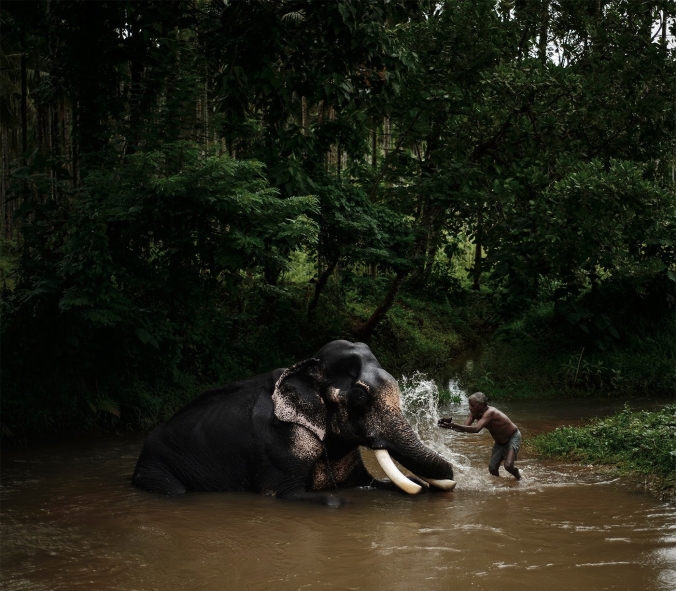
ആനയും ആനക്കാരനും തമ്മിലുള്ള ബന്ധം എത്രത്തോളം ആഴമേറിയതോ, അത്ര കണ്ട് അവർക്കിടയിൽ പ്രശ്നങ്ങൾ ഇല്ലാതിരിക്കും. ചിത്രം കടപ്പാട്: അനീഷ് ശങ്കരൻകുട്ടി
Elephant in the Room: From Reactive to Proactive
It had only been couple of weeks since the day my friend and I last saw Krishnan and Arjunan, at a festival at Kunnamkulam, near Thrissur. To anyone who’s not into this field, it may sound like meeting two companions; but in this case Arjunan is a tusker in his prime, and Krishnan is (was) the mahout. Krishnankutty—Krishnan alias Velichappad Krishnan as he was popularly known among peers and others in the field—started working with Arjunan as his mahout nine years ago, a time when Arjunan was noted for the unrests he had caused. The duo seemed to share a bond quite well that Arjunan, the dominant bull, in the recent past hardly featured in newspapers and was preferred by several festival committees who never wanted mishaps by tuskers, which today is a common scene in the state of Kerala. All said and done, Krishnan met with a tragic death in the wee hours of 10th of February this year, when Arjunan struck him with his heavy tusks. The reason was, apparently few festival committee members approached Arjunan without alerting Krishnan, and in an attempt to defend them Krishnan received the heavy blow. Several versions of the story could be heard among ‘elephant lovers’ in the state, but truth behind is something only Krishnan or Arjunan could’ve told us.
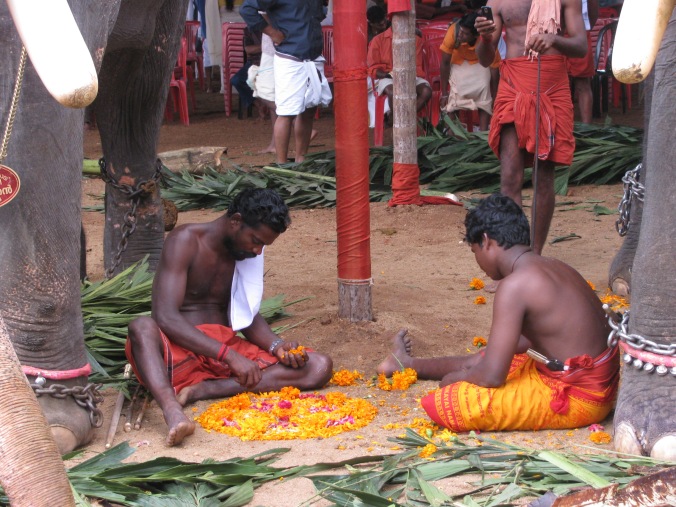
Image 1: Krishnan sitting next to Arjunan and laying a floral carpet during Onam at Thrikkakkara temple near Cochin (Courtesy: Sreehari Venkateswaran)
Now this is not the crux of the argument that I’m making here; a mishap that could have been avoided, the Krishnan-Arjunan story is a classic exemplar of the (almost) day-to-day elephant attack incidents the festival towns witness. Of the three dozen odd incidents that happened this year (in 55 days starting January 1st till 24th February), most were caused either as a result of provocation of the animal by bystanders or by mahouts (for head lifting) or because of the animal being in stages of musth. And in all these cases, the losses incurred in terms of property damage, injuries to humans and to conspecifics could have been avoided, had there been some proactive measures adopted. To draw a parallel with damages caused by wild animals, efforts to curb those have, often, been reactive involving removal of the animal involved, physical barriers etc. which all have unfortunately failed in most cases as opposed to proactive ones such as early warning systems. However, interestingly, none of the aforesaid three dozen odd incidents this year or several such in the past have ever prompted our public or the stakeholders involved to adopt either reactive or proactive measures, which is evident from the repeated number of incidents caused by same individuals, or in same locations. To quote a few examples — the Pazhanji church festival near Kunnamkulam in Thrissur district which occurs in October every year witnessed elephants running amok and spreading panic consecutively in 2013, 2014 and 2015, Cochin Devaswom Narayanan ran amok thrice this season and so on. Despite such repeated incidents in particular locations or often by particular individuals, no effort is undertaken either by authorities or by public stakeholders for successful prevention of the same.
In an effort to understand the problem in greater detail, and to communicate with direct stakeholders of the captive elephant sector in the state, some of us found genuine elephant owners among the lot, who agreed with our team regarding flaws in management practices and accepted the need for greater reforms in the immediate future. And it is quite intuitive and true that these proactive owners, who are ready to accept changes, have never, in the recent past, had their animals turning unruly or facing a legal or socio-political problem because of that.
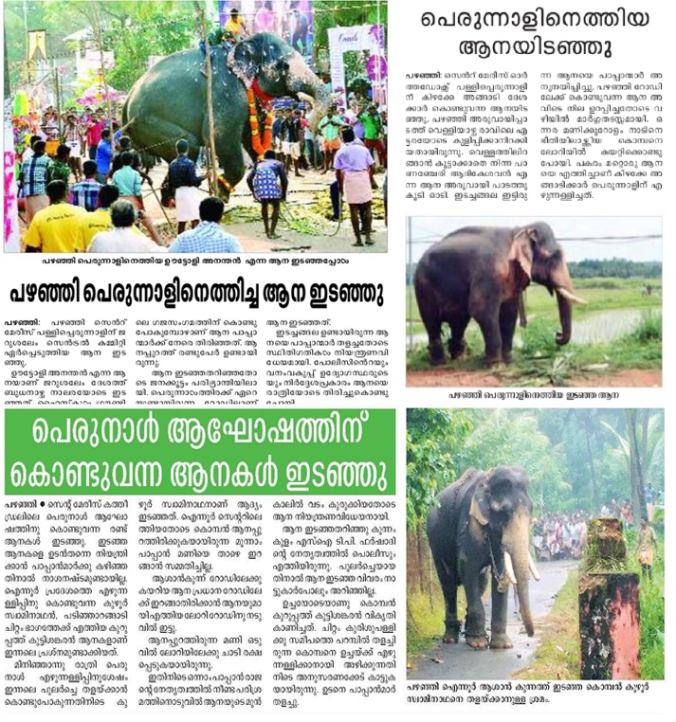 Figure 2: Newspaper reports (in vernacular language) showing elephant attacks in Pazhanji festivals in 2013, 2014 and 2015 respectively (Courtesy: Mathrubhumi dated 03rd October 2013, 04th October 2014 and Malayala Manorama dated 04th October 2015)
Figure 2: Newspaper reports (in vernacular language) showing elephant attacks in Pazhanji festivals in 2013, 2014 and 2015 respectively (Courtesy: Mathrubhumi dated 03rd October 2013, 04th October 2014 and Malayala Manorama dated 04th October 2015)
The situation like never before has received considerable media attention this year — thanks to social media platforms and activists. However, what is unfortunate in these cases is that the media reports and petitions are vain efforts, considering the fact that these have brought forth hardly any change on ground. Increased number of activists indulging themselves in raising voices against elephants in captivity also gave hope to concerned bunch, but most efforts seem to be restricted to media attention and social media virality. There are also efforts by several of them to fabricate stories (See http://peepli.org/blog/2015/08/18/temple-elephants-and-what-lies-beneath/ to read about a fabricated story that appeared on The Daily Mail) on elephant management flaws in the state thereby raising false accusations against many which also seem to result in genuine individuals losing ground. The fact that Likes and Tweets cannot help animal lives is something everyone needs to be aware of, and online campaigns have a limit to which they can influence the local public who are directly involved. Moreover, a ban of these current practices raises a whole lot of questions considering the magnitude of the issue.
Two decades ago, the apex court of India banned all commercial logging activities in the Northeast following the landmark Forest Case by Godavarman Thirumulpad (WP 202/1995), thereby leaving hundreds of elephants in that part of the country ‘jobless’. Unable to meet the expenses of these animals in the absence of any income, most of the owners sold off their elephants to Kerala and Tamil Nadu at the annual Sonepur mela in Bihar. However, immediately after the ban, several ‘jobless’ elephants were found begging along the streets of several states such as Assam, Arunachal Pradesh etc. Men who acted as saviours and saved them from malnourishment and death, brought them down south to be paraded across pageantries. Now when the ban on parading jumbos at festivities across state receives wider acceptance and comes forth into action, the immediate question is to rehabilitate these 580 odd registered and few other non-registered individual elephants.
My exposure as a wildlife biologist has given me immense opportunities to visit rehabilitation centres, State Forest Department elephant camps and rescue centres, and seeing all that, with a great degree of confidence I can state that the problem of rehabilitating these animals will be the greatest uncertainty ever. These are wild caught, tamed (not domesticated) or trained, mostly adult, animals and cannot be sent back into the wild as is being argued by several of these aforesaid (social media) activists. More importantly, while our wild counterparts are striving hard to cope with habitat degradation and loss on a day-to-day basis, we cannot afford to set aside anymore forest areas to rehabilitate such large numbers of elephants. And also, it is a known fact that several of these captive animals suffer from infectious diseases such as Tuberculosis and their proximity to wild habitats can increase the chances of wild elephants contracting the same. Most of these animals, from their childhood have been trained in the traditional way of dominance establishment and will not immediately accept a new person as his or her mahout. Management issues such as lack of space, food and water resources, trained personnel to handle, and more importantly monetary resources will all be questions staring back at one who attempts to rehab such a large number.
Each elephant attack sounds a step closer to the ban argument to the activists; but while their efforts to ensure welfare of these animals are appreciable, it is also advisable that they approach the issue more pragmatically, than knee-jerk reactions. As always, being reactive will only worsen the situation and one needs to be proactive if the objective is welfare and management of a (fairly) large population of the largest living land mammal in the country. And this can be achieved not through social media debates, arguments, ‘viral infections’ and press releases, but through constant engagement with stakeholders beginning with middle-class festival connoisseurs to mahouts to large-scale elephant owners and festival coordinators. Attempt it; positive stories are on your way.
***
Elephant in the Room – III
________________________________________________________
Republished from India Facts dated 27th January 2016
________________________________________________________
Kerala court releases elephant on bail
~March 12 2013, The Times of India
Murder attempt on blind tusker: Killing opponent’s elephant for revenge is not new to Kerala
~August 11 2015, The News Minute
At times, it all sounds like a fairy tale; sometimes like a psychological thriller—the Hitchcock kind. Drama and suspense unfolds every day as elephants are paraded on streets and in religious institutions, thanks to their stardom and fanfare. With stardom comes ego clashes, petty fights and controversies, they say. The lives of these gentle giants in captivity, which started as draught animals, then as war machines and later as royal adornments, have changed manifold in the last decade and half. From the days of reverence and admiration for elephants, which arose from close associations with them, personification of these beings have gone to a totally different level today as exemplified by the aforementioned news headlines. Elephants are the golden geese today. With growing ‘devotion’ and competition, numbers of elephants in pageantries have increased several times; and the number of such lineups too. Although activists and media call them ‘temple elephants’, it is time one ruled out the terminology; they are now part of processions across religious institutions. With rising competitions and increase in money involved, there’s burgeoning politics and in the cost-benefit analyses of these episodes, the pachyderms bear the cost.
In January 2013, Ramachandran, the tusker mentioned in the headlines above, ran amok in a temple near Cochin, and killed three innocent women bystanders. The half blind animal, tallest tusker in captivity, perhaps, is one who has borne the brunt of fanfare and stardom as is evident from his life history. Perhaps owing to stress and trauma during early part of his life, he has a bad temperament, which cost him an eye, and also the lives of two other tuskers and eight humans. This is not just the case with Ramachandran, but several others who with their padded worn out soles still march the festival grounds of Kerala. Increasing stress could sometimes lead to redirected aggression, which can cost a life or two or sometimes more, of humans and even elephants. Social media radars have been quite active this festive season (which started in September 2015) and updates on networks show that till date there have been fifty odd incidents of elephants running amok across the state. Since December 2015, the number’s been over thirty, and the human death toll being four (three mahouts and a bystander), including the last one at the renowned Sabarimala temple. In three of those four cases, the individual elephants have had previous case histories, of killing or injuring people and then the pertinent question remains why such individuals are paraded. The answer is fairly simple; rising demand for elephants at pageantries due to their increasing use in processions—religious and non-religious—has led to the use of musth elephants (by suppressing musth using antiandrogens and antipsychotics), ones that were kept away from processions due to their case histories and temperament, and also injured or diseased individuals.
The Kerala Captive Elephant (Management and Maintenance) Rules 2003 (amendment 2012) is a fairly comprehensive legal document that prescribes norms for using these animals categorised under Schedule I of the Wildlife Protection Act (1972). What is unfortunate is that in most cases, none of these norms, regulations or recommendations is followed. In a recent incident, a tusker ran amok and attacked another, after which he was brought under control. Identifying signs of musth, the tusker two days later was taken for timber hauling (Rule 7(7) of the aforesaid document states that an elephant in musth shall not be put to any work) which led to the animal running amok and killing its assistant mahout or cavady. As in this case, most such incidents are avoidable and are results of direct violations of the norms. Five or six people (sometimes up to ten) ride an elephant as part of these ‘cultural’ processions, amidst jeering of the crowd, loud crackers and drums; some even bursting confetti party popper atop elephants! For any parade or work, an elephant is supposed to be certified fit by an authorised veterinary doctor and the fitness certificate is yet another document that is often either falsified, or issued by vets who sometimes don’t see the elephants, or even used for multiple parades and transportation (rule 4(18) states fitness certificate to be issued prior to every transportation). Recently an elephant that was used (and is being used) for festivals had deep, open wounds on his hind leg, resulting from torture from mahouts as part of the routine breaking process. Interestingly, despite that, the elephant did have a fitness certificate issued by a renowned vet in the state, which even stated that the animal is free of injuries, diseases or illnesses and is fit for work.
Images: Thathamangalam angadi vela, near Palakkad. Notice the number of people atop each elephant. One mishap could cost numerous lives. Photo credit: Aneesh Sankarankutty
When the rules were framed in 2003, with welfare of elephants in mind, the committee proposed trucks for easy transportation of elephants. But contrary to expectation, the vehicles only added to their stress by shuttling them between faraway places faster. Our initial analyses show that many elephants travel anywhere between 3000-3500 km during a festival season between September and May covering an average of 140-150 festivals. Being highly mobile species in the wild, lack of exercise, and constant movement in trucks seem to add to their ailments, particularly related to their feet. Their apprehension and fear of unstable surfaces also adds to the stress and trauma they undergo as is evident from the behavioural traits exhibited by most elephants during these truck journeys.
Things have gone from bad to worse after rampant leasing out of elephants began since early 2000s. Recently an owner (who didn’t want to be named due to political reasons) stated that in the district of Palakkad alone, there are 75-80 agents or brokers, who are middlemen between elephant owners and festival committees, and mint money. Despite legal provisions being in place, these rampant monetary transactions on a Schedule I animal are ongoing. An auditor (who again didn’t want to be named) in central Kerala pointed out that the captive elephant sector in the state is ground for monetary transactions coming up to millions of rupees annually. As these elephants are rented out by most owners or agents without an invoice, bill or receipts (except for certain temples, who do issue receipts for payments made) most of these transactions are not taxable, he adds. The average rent of an elephant has gone from four digit numbers to five and six digits today, and given that, one can imagine the business interests of this sector.
The way social media is used for these is also getting worse with more and more FB pages being created for these celebrity elephants, and online debates, arguments and fights happening every minute. The pressure from fans and followers prompt most mahouts to compete with other mahouts and elephants in what is popularly called ‘head-lifting’ competition (where an elephant has to raise his head higher than others and stand for minutes to hours motionless, even without flapping ears!), something that the owners’ association vouched that they will abstain from, but continues to happen even till date. Video evidences of elephants being poked and beaten for lifting their heads have gone viral on social media, with activists and concerned people raising their voice and despite all that concerned authorities have failed to respond. Such fights among fan groups also trigger rivalry among mahouts who want to compete more at the cost of anything, taking us back to the headlines mentioned in the first part of this piece.
Images: Head-lifting competitions in progress (Notice the raised heads of elephants)
Photo credit: 1. Anonymous/FB 2. Author
What everyone seems to ignore or overlook is the fact that this indeed is a sinking ark, from where elephants are disappearing gradually, succumbing to stress related disorders, colon impaction and so on. Till recent days, there was some hope that the forthcoming days would witness positive changes in the sector, but the antithesis is slowly happening; thanks to everyone involved.
Hindsight — The irony: The same public who raise outcries and protests against wild elephants coming to croplands and occasionally damaging crops or costing a life or two accidentally, seem to accept numerous such deaths caused by these so-called living gods in chains. While these captive ones get away with their cases, their wild counterparts are paying huge toll in the form of retaliation by humans. Heights of irony indeed!
Elephant in the Room – II
_____________________________________________________
Republished from India Facts dated 30th December 2015 (http://indiafacts.org/elephant-in-the-room-glimpses-from-the-past/)
_____________________________________________________
Glimpses from the past
Mātangalīla, the magnum opus by Nīlakanta dates back a few centuries, Malayalam Era (Kollavarsham) 761 according to the interpretation of the text by Cheruvalli Narayanan Namboothiri[1] and an English translation of the text by Frank Edgerton[2]; Pālakāpyam, the one that formed basis for the former however was written much earlier, although the exact date is unknown. There are anecdotes and arguments raised with regard to historicity of elephants’ association/or their use with/in temples and other religious establishments, which is the central part of the Elephant in the Room, although a detailed attempt at arriving at more reliable estimates of the period is lacking. Neither Mātangalīla nor Pālakāpyam does not mention about use of elephants in temples or for religious practices, and both these texts that deal with good and bad signs of an elephant (śuba-aśuba lakshana:), musth, treatment and daily care, trade and price determination, talk of elephants as vehicle for the kings (…sa: gajō rājavāhana: for instance). The earliest use of elephants in temples of Tamil Nadu mentioned in historical sources similarly state that they were primarily used as draught animals, to carry water to the sanctums and also for transportation. However in Kerala the scenario is different, even the oldest records available talk about pageantries. The dissection of the current state of elephant management in the state of Kerala is not complete without understanding the historical relationships and the changes that have followed. It is also important to understand these historical patterns to better unravel the lacunae in welfare and management, which is the immediate question to be addressed. This part of the series will delve more into the past, attempting to throw light on practices of the yore.
Historical accounts on elephants at festivals
The oldest pageantry of caparisoned pachyderms in Kerala is believed to be the Arattupuzha pooram, an annual cultural extravaganza parading tens of elephants (at one point believed to have paraded 108 regularly). Also called the devamela or devasangamam (meeting of the gods and goddesses), the Arattupuzha pooram is ~1400 years old (oldest inscription being in A.D. 583), and is perhaps oldest in the subcontinent. However it is still not well known as to when the use of elephants in the processions began. The Thripunithura temple of Cochin Royal Family also have stories to tell of processions as old as a few centuries. Legend talks about Saint Vilwamangalam visiting the temple and watching the majestic pageantry parading 15 elephants. On investigation of the history of these festivals, records or evidences on use of elephants begin from the 1700s to 1800s, showing that the use of elephants in temples is perhaps ~200-250 years old, although elephants in captivity dates back more than a millennium. This estimate is also in accordance with the dates mentioned in Aithīhyamāla (garland of legends in its literal sense), a magnum opus that describes legends of erstwhile Kochi, Malabar and Travancore, by writer Kottarathil Sankunni, where he also features the lives of eight legendary tuskers. Pepita Seth in her book on Guruvayur[3] while mentioning its history also raises the falling-out between the then Maharaja of Cochin and the Zamorin Raja, as early as 1780s, and how the former disagreed to send elephants from his royal stables to the annual festival of Guruvayur. This again is consistent with the earlier dates.
The Cochin State Manual by C Achutha Menon, in a section on elephant capture by the East India Company mentions about the capture of elephants in large numbers from the forests of Cochin for the Imperial Forest Department. Towards latter part of 1890s, the department had 20 elephants under their charge in Cochin region, 8 belonging to the Government and 12 to the Devaswom (the temple management), indicating that the temples did have elephant pageantries back then. The Malabar Gazetteer similarly talks of elephant captures by Nilambur and Kollengode rajas. A mention about the crescent shaped designs on the nettipattom (headgear part of caparisons) of an elephant in the Aṣṭamiprabhandhā written by Melpathoor Narayana Bhattathiri (1559-1645), could be a potential evidence of elephants in temples as old as late 1500s to early 1600s. What seems, nevertheless, evident and agreed upon by most to a greater extent, is that these pageantries are a reflection of a more feudal era as is evident from the oldest festivals that are more or less associated with princely states and the royal deities.
Practices of yesteryears
From being war machines of Carthaginian era and Mughal days, elephants later became symbols of pride and pomp in the yards of Rajas and Sahibs. In Kerala, particularly, most affluent families of yesteryear had dozens of elephants often caught from their own forestlands, the royal family of Nilambur and Koyappathodi family of Calicut being classic exemplars[4]. While emphasis was on the display of these beauties, welfare was never overlooked. In the days of yore, emphasis was laid on elephant — mahout relationships that often lasted ages, till the death of either of the two, unlike today. Of all the various such examples, the most celebrated one is that of the legendary Guruvayur Keshavan, whose tales are carried by the winds of elephant countries of Kerala even 39 years after his demise, not just because of the qualities of him, but also because of the bond he had with Achuthan Nair, Mani Nair and several other mahouts. This relationship was in fact even celebrated on big screen by filmmaker Bharatan in his 1977 movie titled after the tusker. Aithīhyamāla, the text mentioned earlier also talks of similar elephant — mahout relationships.
Mātangalīla compares a mahout to the head of a state (Nāgādhyakṣasthu dhīmāna narapati sadr̥śō) stating that a mahout should be loyal to his profession and to his elephant like a king to his subjects, and emphasises on his responsibilities and priorities. Trained in and well aware of elephant behaviour, physiology, and diseases and their treatments, mahouts dealt with most problems back then, even including behavioural or psychological ones. A proper shower of an elephant, for instance, lasted a few hours during which communication between the mahout and the elephant, verbal and tactile, helped in strengthening the relationship. Hasthyāyurvēda underlines the importance of such long baths from a physiological perspective and how it aids in increasing blood flow and improving health. Elephant management back then was also a collective responsibility, where the owner and the mahout ensured the welfare of the animal unlike what it is today.
…To be continued…
[1] Namboothiri, C. N., 2009. Mātangalīla. Arthavedīvyākhyānam. Santha Publishers,
Kodungalloor.
[2] Edgerton, F., The Elephant-lore of the Hindus: The Elephant Sport (Matangalila) of Nilakantha, 1931, reprinted by Motilal Banarsi- dass, New Delhi, 1985
[3] Seth, P. 2009. Heaven on Earth: The Universe of Kerala’s Guruvayur Temple. Niyogi Books.
[4] Daniel, J. C.1998. The Asian elephant: a natural history. Natraj Publishers.
Elephant in the Room – I
________________________________________________________
Republished from India Facts dated 24th November 2015
________________________________________________________
Prologue
In a letter dated 14th October 2015, the Minister of State (Environment, Forests and Climate Change; henceforth MoEF & CC in the series), Shri. Prakash Javadekar wrote to the Minister of Women and Child Development, Smt. Maneka Gandhi—in response to an earlier email she had sent—announcing the Bihar State Board of Wildlife’s decision regarding banning transport of captive elephants from Bihar to other states and vice versa, and also banning their sale, purchase and transfer across the country. This received considerable attention in several regional and national dailies, and in several forums on social media. To many, however the larger context (or relevance) of the order was (is) not very clear. The objective of this article, and the forthcoming ones in this series—titled the Elephant in the Room—is to deal with various issues and shortcomings in captive elephant management sector in the country, with emphasis on the southern Indian state of Kerala, which boasts of its centuries old association with the largest land mammal, in captivity.
Elephants are perhaps the only other wild animals, apart from primates that have had such close associations with humans since time immemorial. Their associations range from battlefields to backyards, where they stood as living symbols of royalty, pride and pomp and also as an icon of intelligence, emotions and personhood. Personification of elephants can be attributed to the worship of the elephant-headed god Ganesha, who according to Hindu mythology is the remover of obstacles. This reverence to a greater extent has helped in well-being and conservation of the animals during the earlier days. However commercialisation of elephants have taken a toll on their lives since recent past, and today, the growth of this sector as a multimillion dollar industry has worsened to a deplorable situation.
Apotheosis to Apocalypse
Evidences for commodification of elephants can be found in the magnum opus Arthashastra, where the author Kautilya emphasises on creation of Gajavana or elephant forests for protection of elephants, for their later use in wars. Despite mention about their commodification, Kautilya indeed lays emphasis on ensuring welfare of these elephants in these protected reserves. Their commercialisation in the contemporary context, on the contrary however has led to the exploitation of these animals for blind profit, where welfare of the animal has taken the back seat.
From symbols of pride and pomp in royal courtyards of Kerala, large scale monetary transactions of elephants began with their influx from the Sonepur mela in Bihar. The first set of elephants from Sonepur arrived Kerala in the late 1970s not long after the government officially banned the capture of wild elephants, and that was when the floodgates opened. Since then hundreds of elephants have crossed several interstate boundaries and reached Kerala from various parts of India such as Arunachal Pradesh, Assam, Bihar, Chhattisgarh, Rajasthan, Karnataka and Tamil Nadu. Elephants were available in hundreds in the annual Sonepur cattle fair at very low prices, and hundreds of people thronged the banks of the Ganges to buy elephants in large numbers and later sell them in the south Indian markets. The demand kept increasing year after year, leading to more supply by capturing from the wild stocks illegally. The numbers of elephants in the state of Kerala since then have shot up extensively, reaching a situation where today, about ~80% of the tuskers in the state are from the North and North-eastern states of the country. With more influx, there was also an increase in number of elephants being paraded for several existing festivals and there was also mushrooming of several new celebrations that parade large numbers of elephants. With increase in number of elephants and opportunities for monetary gain, captures and merchandises of elephants became rampant, making them a commodity rather than an intelligent companion and the apotheosised beings started undergoing apocalyptic transformations. With 36 in 2013 and 24 in 2014[1], the state is losing elephants every year in a way that the system has never witnessed before. Bulls of 30s and 40s—in their prime—are losing their lives to colon impaction and foot rot and other fatal diseases, which to a greater extent can be attributed to the workload, stress and mismanagement.
The elephant in the room, what we’re not talking about, certainly is this (mis) management of elephants in captivity, and how one should go about with the current system, which seems to threaten the very existence of these animals. Elephant welfare debates and arguments and outcries have always happened at the occurrence of a mishap but the lack of a set of reforms (for the lack of a better word) to mitigate the distress of these gentle giants is the need of the hour. And that is what this series is aimed at.
[1] Reports by the Thrissur based Heritage Animal Task Force
Pachyderm Politics
When Chami started working as a mahout at the age of 12, about 60 years ago, the captive elephant management scenario in Kerala was very different from what it is today. Back then, he recalls, elephants were symbols of pride and prestige, unlike today, where they are mere money-spinners. There weren’t any Biharis and Assamese, as Chami and other people associated with elephants call the ones from the Sonepur mela and North East. Sixty years later, retired from work, sitting in the verandah of his small home amidst rubber plantations in Parasheri village in Palakkad district of Kerala, Chami’s grief at the plight of captive elephants shows on his face as he speaks. This is not just the view of Chami. His voice represents that of the community of senior mahouts in Kerala. They fear that the new-generation mahouts, who are often mindless, are leading to slow abjection of a centuries-long tradition. A lot of this has become as a result of the change in the way people view elephants. From their status as the living forms of Lord Ganesha, today they’re more revered as celebrities, treated in a manner similar to actors and rock stars, with their own fans associations. This also has made profound influence in the socioeconomics behind the scenes, and I have observed the transformation happening over the past decade and half, from various perspectives. Since there’s a lot more money involved in the business, the art of ‘mahoutry’ as I would put it, has slowly given way to a mere profession aimed at gaining more money. And it was these stark shifts that prompted me to take a short detour from academic days through the land revered for its historical associations and personification with the largest land mammal.
Mahoutry through the ages
Historical records attest that Asian elephants have been kept in captivity as early as the Mauryan Empire (322 to 185 BCE). Since then, elephant capturers and mahouts have sprung from local communities, passing their skills on to further generations. From moods to musth, foot-sores to dysentery, mahouts understood every aspect of elephant management through their traditional practices and long associations with elephants, which made them repositories of knowledge. Matangalila, a millennia old Sanskrit textbook, talk about the biology and management of elephants in captivity besides emphasizing on the ideal characteristics of a mahout. Known for their proficiency in Matangalila, mahouts were once respected for their skills in associating with the largest living land mammal. The opening of the twelfth chapter of Matangalila, written by Nilakantha, classifies the mahouts into three categories as Balavaan (the strong and careless), Rekhavaan (the concerned) and Yukthivaan (the diligent) based on their attitudes and relation with elephants. Most mahouts of yesteryear were well versed with the lore, the practices, and importantly the individual idiosyncrasies of the elephant that was in their charge for years. Years of apprentice to senior mahouts, before becoming an independent mahout themselves, trained them to understand elephant behaviour and care and this was crucial in strengthening the relationship.
Journey from command to chemicals
The elephant-mahout relationship used to be a strong bond, an inseparable one, which mostly lasted for decades. (In the order of elephant and mahout names) Koodalattuparam Ramachandran and Gopalan Nair, Mangalamkunnu Ganapathi and Sankaran, Thiruvambadi Kuttisankaran and Narayanan, Thayankavu Manikandan and Gopalan are some of the greatest examples of such relationships. However, in recent years, with changing practices, the tenure of a mahout with an elephant lasts not more than two to three years.
“I learnt the art of being a mahout from my father, and other senior mahouts like Ramachandran Nair”, says Mani, one of the younger mahouts. Mani started working at a very early age, about fifteen years ago, because of his ardent love for the animal. Today things have started changing. Socio-economic and cultural changes have transformed the communities, and the elder mahouts are reluctant to send their wards to this profession considering the wide range of risks that are involved. Considered by most seniors as a promising youngster in the profession, Mani faces opposition from his family, who wants him to quit the job and find better employment in the Middle East. His family is also concerned, that because of the negative perception of the public towards mahouts, they will not be able to find him a bride. Other youngsters are not as interested as Mani is, and many have hardly gained experience as apprentice to senior mahouts, or understood how to handle difficult situations, such as an elephant that goes out of control.
“Tusker runs amok, injures fifty, causes damage to properties”, newspaper headlines like this have been part of the business and this is not new to Kerala’s experience. The 1800s writer Kottarathil Shankunni writes about the heroic tales of yesteryear tuskers and stories of them running amok. But those days, Chami says, mahouts were trained specially to handle violent elephants, and each restraining device, command, and procedure had a purpose and mishaps like human death or injury happened rarely, only in the worst of all cases. In 1979, Kizhakkeveetil Damodaran, a ‘celebrity’ elephant ran amok in a village called Thirunellayi near Palakkad, during a procession terrifying people and damaging property. And that was when it came into the picture, and for the first time in the history of captive elephant management in India, an elephant was brought under control, not by traditional restraints, but chemicals: xylazine hydrochloride fired from a tranquilizer gun. Since then, more than about a thousand incidents of elephants going out of control have been dealt with the help of xylazine. Today 90% of all elephant attack incidents are controlled by the use of tranquilizers. Most cases of elephants running amok happen due to the elephants being in the state of musth, a physiological condition due to increased testosterone levels and characterised by heightened aggressiveness.
Not so pleasant winds of change
On a rainy day in Guruvayur, as he smokes his favorite roll of tobacco, Unnikrishnan, another senior mahout, argues that tranquilizers have been harmful to elephants, in a manner the traditional ankush, a prod of hooked iron, never was. “The ankush may cause external injuries that heal in a while considering the habits of elephants. But the chemical [xylazine] has prolonged effects on musth of elephants and sometimes it even causes burning of skins causing it to tear off [necrosis]”. He adds, “Youngsters support the use of tranquilizers mainly because it is effective in bringing elephant under control immediately, whether you have the mahout’s skill or not”. And when he says this, he’s absolutely right and this attitudinal shift in mahouts have made them less responsible and prompted them to put even musth elephants into work. The numbers of elephants that have died in the past few years or a decade are evidence for the infliction of vicious acts by the young inexperienced lot. Besides ankush, long pole and hobbles these folks now resort to crowbars, sickles and even phosphorous to bring proclaimed rogues under control. Prakash Shankar and Arjun are two young bulls who met a traumatic end in 2009 and 2012 respectively; the former suffered deep wounds on hind legs inflicted by crowbars and the latter had fractured legs caused by a spade!
Such changes in captive elephant management portray dismayingly how the fading of mahout traditions affects the plight of captive elephants. Despite all this, capture is still being suggested as an option to mitigate conflict. Twenty-two elephants were removed from Hassan district in Karnataka, over a period of about six months, earlier last year, as a solution to rising conflict in the area. Experts claim that leaving behind viable populations of elephants, so-called ‘problem elephants’ and ‘rogues’ may be captured to mitigate conflict. But as a matter of fact, capturing/translocating elephants has high chances of leading to more conflict as peripheral herds may move out and colonise the areas from where elephants are captured. But before all that, one needs to defend what defines viable populations and ‘rogues’, although all those are completely different debate. Despite that, capture is being suggested as a viable option to mitigate conflict and recommendations are being made in India for large scale capture of elephants from conflict prone areas. What is overlooked in this case is the fate of these animals in captive conditions, at various forest department or private camps, considering their social status in wild. More challenging is the complexity involved in taming the animals, especially in states like Kerala where mahouts are being more endangered than the elephants. The evanescence of the mahout tradition is evident; there is a great shift from its earlier cultural form to a career people prefer when left with no other option, which has led to reflection of their desperation on elephants in the form of tortures.
As he drives back from the first festival of the season, the Thiruvilwamala Niramala, Aneesh, an elephant enthusiast recollects days during which elephants used to get proper rest, their health ensured. Aneesh who has regularly attended major festivals in Kerala for the last two decades, now restrains himself from attending any. He says, “Many factors have led to tremendous negative changes in the captive elephant sector, a major one being the rise of elephant fan associations that give celebrity status to these poor pachyderms”. He also reminisces how five to seven elephants used to line up for festivals in the past, with hardly any mishaps. In the rare case of an elephant attack, people were usually unaffected, only the mahout being the victim. Deplorably, today many spectators also suffer, such as when the elephant Kalidasan ran amok during the Thrissur Pooram, an annual cultural extravaganza in 2012, or when Thechikottukavu Ramachandran killed three women bystanders at Perumbavoor near Kochi in January 2013. Increasing the number of elephants at each festival has also led to tremendous increase in demand for elephants, as a result of which they are most often overworked, stressed and unhealthy, says Aneesh.
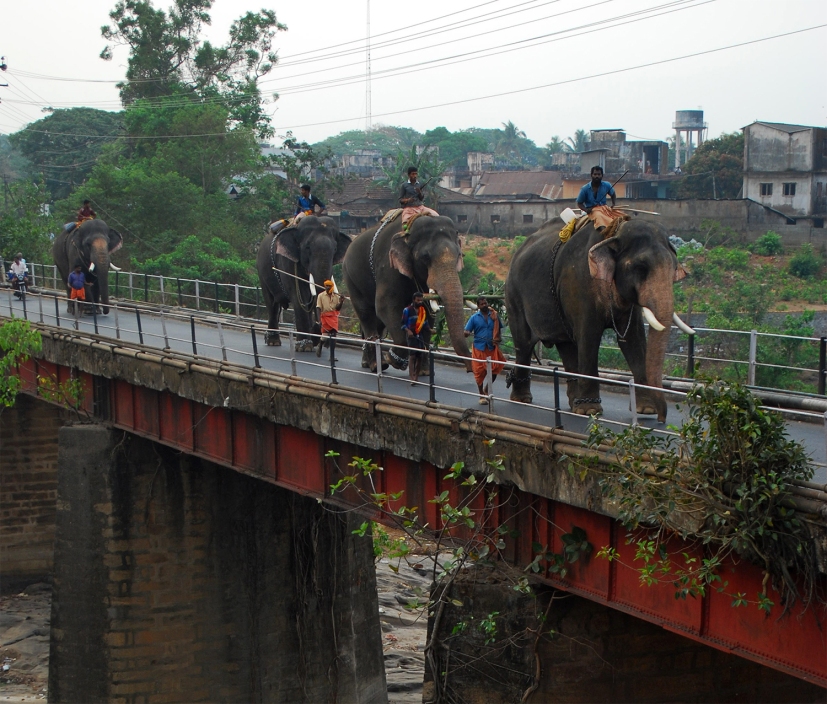
Elephants walking from one festival place to another–a scene from 2000s. Courtesy: Aneesh Sankarankutty
Reports prepared by the Thrissur based Heritage Animal Task Force show that 36 elephants died during the festive season in 2013 and 24 in 2014, most of them under the age of 40, due to overwork and abdominal disorders. These can be clearly attributed to long and strenuous work timings and travel by trucks that are stressful to elephants. Despite several restrictions being in place, including speed limits of the carrying vehicle, they are often violated to ensure timely arrival at a faraway festival place. Most elephants in Kerala are made to stand attendance at about 100-odd festivals every year, traveling roughly 5000 kilometres. In Chami’s prime days as a mahout, he used to walk the elephants for miles from one festival place to another, making stops and availing sufficient rest along the way. As he recalls, those days when three or four elephants used to walk together through the countryside, collecting forage, enjoying toddy pit stops, the elephants rarely knew uneasiness and stress. Today, with vehicles and roads, their travel has become traumatic. Contented of living up to his dreams, training his boys as one of the best set of mahouts in the state, Chami still maintains a ray of hope about the plight of Kerala’s five hundred odd elephants; he’s still hopeful that the winds of change are not far away and that the new generation will soon realise the grave danger they pose to the elephants in the name of celebrityhood and fanatic devotion.
______________________________________________________________________________________________
Note: This article was originally published in the Saevus Magazine, September 2015 issue. Reposted by the author on the blog, with additional photographs and hyperlinks.
______________________________________________________________________________________________
An Open Letter
An open letter to all self-proclaimed (social network) elephant lovers
All these days, I’d shunned myself from responding to animal/elephant welfare related posts online, and comments and discussions that followed, simply because I never believe in futile debates and arguments. But at this point, I am putting down my points blatantly–thanks to some bitter experiences. I’m appalled by the information being passed on by several individuals/organisations about elephants of Kerala—often as shoddy journalism, unfortunately—in the name of facts, many of which off late are baseless allegations. Typical example for this is a latest article in which one of the several random photos posted is that of a musth bull elephant displaying a behavioural trait–a trait common during musth–and the caption reads as atrocities and elephant suffering due to confinement.
The last two years have witnessed substantial increase in the number of elephant lovers all across the state of Kerala, who through social networking sites have been promoting “celebrityhood” in elephants, which slowly has started spelling doom to these pachyderms. Being someone who’s been closely associated with captive elephant management sector in the state for the past 15 years or so, I have witnessed the transformations happening, and I do admit that the priority over the past few years has been commercialization of the same. And what it–at this point–needs is regulation, to bring down anomalies and to ensure welfare of these animals, not just in papers, but also on ground.
To all the concerned (social media) ‘elephant lovers’
Like I mentioned earlier, I do admit that there have been stark changes that have been happening in this field, which has not been very positive to elephants, and also several mahouts. The way to prevent the whole process deteriorating any further is not by fighting online, not by raising voices within, not by making ridiculous arguments/photographs/videos and protesting against, but by working more closely with the stakeholders, and realising that it is not an overnight change; It needs slow phasing out. Clearly this is not like rescuing and rehabilitating one or two elephants, we are talking about hundreds. Yes, you heard me fairly loud; Hundreds of elephants, for which you will have to find shelter, caretakers, water, food and what not.
Most western arguments about captive elephant management in Kerala, or rather India, are around mahouts and their practices. I met a western journalist recently who ridiculed me when I supported mahouts during an argument. The fact that is often overlooked, particularly by these activists is that these people are not born to torture these animals and knowing them, I know that given an option they wouldn’t do any of those acts. It is often true that the mahout – elephant duo do share a bond, which perhaps can be absent in several recent cases as is evident from the various torture videos and photographs. I personally know mahouts who have lost family prioritising elephants over them and mahouts who have lost mental health following demise of their elephants, and these portray the deep relations they maintain(ed). However there are stray incidents off late, where elephants have been abused badly by mahouts but blaming them completely for these actions perhaps do not make sense considering the fact that the ownership of these elephants do not lie with them and they are overseen by the owners.
Let me also use this space to answer some of the common queries I have been getting.
- Why not rescue and rehabilitate these elephants to our forests?
Please understand that these are tamed wild elephants, living for years—in most cases, decades—with humankind and are used to the captive conditions that prevail. They will certainly find it difficult to acclimatize to the conditions there, once rehabilitated back, and survival could be at stake in most cases. We’ve also had cases where formerly performing animals where released back to wild, who later got into negative interactions with humans. Moreover, where do we have enough forests to rehabilitate all these elephants, when 80% of our wild elephants are roaming outside conventional protected areas, closer to human habitations? Hence rehabilitating them back to wild is clearly not a possibility.
Besides the impracticability, there is a larger problem within this, which is the chances of TB—highly prevalent among a larger proportion of captive elephants—spreading to the wild counterparts, which could in turn affect larger populations.
- Why not release them into degraded forests or unused large extents of land?
How do you define a degraded forest in this context? I do agree with ecological role of elephants to the forest including seed dispersal. However elephants also negatively impact vegetation as known from several studies in African savannas and observations along elephant camps. As a result of repeated feeding in confined areas, the local vegetation suffers dramatic loss in turn leading to colonisation of those areas by invasive such as Lantana and Eupatorium. And we must keep in mind that in India, the question of acquiring land for elephant sanctuaries is likely to be a huge challenge considering there is so little in comparison to the demand, and the small bits of reserved forests cannot be further converted at the cost of other effects.
- Lets rehabilitate them in camps.
When existing resources (money, manpower etc.) are becoming insufficient to maintain elephants already present in forest camps, I do not see it as a feasible option at all.
- Then what do you do to control all this?
The solution to every problem underlies in understanding it at the grassroots level. In this case, most of the people who are vocal against these problems—from my limited knowledge—seem to be fairly unaware of the actual ground reality and cast their opinions based on what is portrayed in national and international media. Please understand that most reports that come these days are completely biased and report random information as facts as is evident from a recent piece in a leading International periodical. There are a few things that can potentially prove to be successful in managing these issues;
- Reducing workload
Most issues raised arise from ill treatment of animals, which is often a result of workloads that burden these animals for a considerate amount of time during the festival season. The only plausible option for that is by ensuring that the amount of work performed by these animals are regulated by stringent rules on ground. This could be in the form of reducing number of festivals participated, distance traveled, procession hours and timings etc. There are instances where an elephant takes part in a festival in Palakkad, and travels to Attingal, near Kollam the next day for yet another (travelling ~320km) and heading back by that evening to Vadakkanchery near Thrissur (travelling another 275km), travelling approximately 600km overall in a matter of 60 hours, which also includes the festival timings. Counter arguments are indeed raised that most of these rules already exist. Let me reiterate my point that it’s not about having these rules just in black and white, but also on ground; better enforced. - Regulating commercialization
As mentioned earlier, large-scale commercialization of festivals and elephants have happened over the last half a decade. This is also influenced to a greater extent by the conferring of celebrity status to these elephants, followed by heated debates and publicity stunts on social media pages and fights between fans associations and so on. And this is what has finally led to appalling number and size of transactions that have happened in the recent times. Putting a stringent regulation on the mushrooming elephant brokers and middlemen would also contribute a lot in reducing the commercial exploitation of these animals. Besides that, it is also to be noted that, although arguments about centuries-long tradition exist and is true to a greater extent, recent competition and commercialisation has led to the inception of several new festivals, many of which hardly have religious/cultural basis, but only monetary one. These processions—most of which parade tens of elephants, carrying more than half a dozen children or men besides other paraphernalia—certainly need to/can be regulated which will contribute to reduction of workload as well. - Better trained mahouts
It is a fact that trained mahouts are more endangered than elephants these days, as is evident from the increasing number of elephant attacks. Week long training camps conducted by concerned authorities indeed are appreciable, but for understanding a complex animal, and learning techniques to handle it better took years for our senior mahouts; how come the younger generations are exempted from such learning experiences? - Reducing work related stress
Travel by trucks can be fairly stressful for elephants, on highways at fairly high speed—not respecting existing speed norms—particularly considering the apprehensiveness in elephants to sudden movements and disturbances. Besides this, often firecrackers are blasted well above permissible decibel levels at close quarters. These are practices not bound by any religious norms and combined efforts could potentially bring them to a halt. - Arresting influx to the state
Despite years of restrictions existing in terms of bringing elephants from other states—particularly Bihar, Arunachal Pradesh and Assam—to Kerala, more elephants have been coming as exemplified by the overall number that has more or less remained within a particular range, despite large numbers of elephants dying over the last 4-5 years.
Overall comments on recent debates
Elephants indeed have been in use for ages in several commercial activities, besides religious and cultural ones. That, however shouldn’t justify the way they are treated today and there should be a new paradigm of elephant management, considering welfare issues while ensuring socio-politico-economical aspects are dealt in a balanced manner. There have been several attempts earlier by several organisations to stop some of these practices. Opposition or lack of support and hostility towards moves to conserve Asian elephants in captivity has often resulted due to lack of clarity in the arguments raised by supporters. This is often because the information they receive—from local and international media—do not give a clear picture about the issues on ground. And that is exactly the reason why legal battles have failed over the last many years. I personally feel that it is very important to get all the facts in place before raising issues against a practice that has been happening for ages—particularly when it is surrounded by religious and cultural aspects. We need to work towards changing these practices slowly and with reasoned arguments based on ground realities, backed by the science of management. We cannot expect an overnight change. But we must start and engage over a long-term to bring about these changes.
An 8-year-old and a makhna named Moorthy
It was the year 1998. Quite an eventful year in the lives of many; Titanic swept away 11 awards at the 70th Academy Awards, US president Clinton gets into controversy, veteran politician AB Vajpayee sworn in as PM of India, Indo-Pak tensions rose gradually setting context for the Kargil war which happened the next year. While all of these events took place, it was an equally—or perhaps more—dramatic and momentous year at the Theppakadu elephant camp in the Nilgiris. A proclaimed rogue, believed to have taken the lives of 23 human beings, was captured after months of outcries and hardships and protests.
An animal of a medium stature, the makhna (tuskless bull elephant) was a dreaded beast to most, who lived and cultivated in the villages bordering Kerala and Tamil Nadu, close to the small town of Gudalur. The villages in the locality woke up to the news of an incident, where a child was trampled to death by an elephant, presumably the same guy. This in turn led to huge protests finally leading to his capture. Although there were proposals to bring him down—thanks to confident interventions of Dr. V Krishnamurthy, forest veterinarian—the officials finally nodded heads to capture him alive and bring him to the camp. After days of waiting and tracking, tensions and miscommunications, he was darted and captured on 21 July 1998.
**********************************************************************
There was an overlord of Anga, famed
under the name of Romapada.
Once he was seated on the banks of the
Ganges in the city of Campa,
when some people reported to him
that all the crops of grain were being
destroyed by wild elephants. The king
reflected: ‘Now what can I do?’
Matangalila by Nilakantha (translated by Edgerton 1931)
Capture of wild elephants, as a conflict mitigation strategy has been prevalent since the days of yore. Matangalila, one of the oldest treatises on elephant behaviour and management begins describing King Romapada of Anga (present day Orissa/Eastern India) listening to the grievances of the countrymen, one evening, who were mourning over their crop losses caused by elephants. The king after further contemplation sent his soldiers to capture elephants that were causing trouble to the peasants of the state, who then brought these elephants to the royal stables.
In the contemporary context, the Project Elephant (PE), initiated in 1992, overseen by the Ministry of Environment, Forests and Climate Change (MoEF & CC) plays the role of the head of state—king Anga. PE, among its various objectives that were formulated in 1992 under the chairmanship of the then director, has resolution of human–elephant conflict as one of its major goals. With growing demands on land resources, necessitated by an increasing human population, pressure on wildlife habitats have been increasing leading to a current scenario where 80% of wild Asian elephants in India roam outside the conventional fortresses of conservation—Wildlife Sanctuaries and National Parks—thereby exacerbating the human–wildlife interface.
Not very different from the days of Romapada, the decisions today dealing with human–wildlife interactions also involve removal of elephants from the problem landscape either to be translocated to a different landscape or to be retained in permanent captivity.
**********************************************************************
There is mystery behind that masked gray visage, and ancient life force, delicate and mighty, awesome and enchanted, commanding the silence ordinarily reserved for mountain peaks, great fires, and the sea.
― Peter Matthiessen, The Tree Where Man Was Born
Moorthy as he was named later after the legendary vet, Dr. V Krishnamurthy aka Dr. K stood silent in the kraal—contrary to the widespread infamous descriptions of him—as an 8-year-old boy walked close to the structure and glanced at him. His lowered head and drooping eyelids—as if still contrived by the drugs that acted upon him a few days ago—made him look spiritless. Clasping onto his father’s hands tightly, the 8-year-old looked in between the wooden bars of the kraal, bewildered, watching a 9-foot animal—wild till a few days ago—listening to the commands of a barely five-and-half foot slenderly man holding an equally lanky Diospyros stick. His impressions about a newly caught wild elephant till then, heard from descriptions the elderly men in the family gave, were that of fearsomeness of a wild 5-ton animal, exemplified by the behavioural displays and its efforts to break free. He was always apprehensive to think of the initial days in captivity of all the bulls he grew up watching.
The journey over close to two decades—ontogenesis, as the textbooks that I learnt would call it—took me through various learning phases, exposed me to several lives comparable to that of Moorthy, and made me realize bitter truths behind and a fairly comprehensive understanding of the complexities involved in human–animal relations in both wild, and in captivity.
**********************************************************************
I stood, holding onto the bar of a kraal, pensive, of Lava’s timid nature; his motionlessness and inactiveness—except when food is offered—reminded me of Moorthy in 1998. Déjà vu; I was already immersed in thoughts, and went back to being the 8-year-old lad, watching Moorthy at Theppakadu. Suddenly I felt a hand on my shoulder; Vinod, my colleague, with raised eyebrows—his looks questioning my raptness—suggested we leave. I realized; the surroundings were not that of Theppakadu; they were different. More Terminalia trees, more elephants, and the voices overheard amidst the wind, and the cicada noises, mumbled Kannada, and not Tamil. It wasn’t 1998, but 2015. And it wasn’t Moorthy I was gazing at; but another unfortunate bull, christened Lava, after the legendary king Rama’s son, captured as part of a conflict mitigation strategy. Sharing the larger kraal complex with him was yet another older bull who was caught along with him, from the same area; his partner in crime, as per the department officials and the locals.
That evening, back at the field station, Vinod and I were contemplating the lives of these elephants—many of them in their prime—caught in the name of conflict mitigation often overlooking their sociality, physical, physiological and psychological conditions. The discussion that evening at the field station was germane, not just because of the visit to the elephant camp earlier that day, but also because, Alur Taluk where the field station is situated, is a name etched in bold letters in the conflict map of India, mostly because of the way it is perceived than the actual conflict. The land has elephant tales to tell, going back decades.
**********************************************************************
Later that evening after visiting Moorthy, I remember, my father was talking about him, tales of him the winds of Gudalur carried with it, the tales that portrayed him into the dreaded beast that he perhaps never was, one more like a 1980s crime thriller. Moorthy, today, is one of the most well-behaved elephants of the Tamil Nadu Forest Department; indeed the efforts of the Kuruba mahout folks need to be appreciated. But beyond that, there is something that always overshadows my thoughts on these; the fact that the 5-ton animal is adapting to live with humans, the behavioural modifications it undergoes and perhaps suppression of its inherent behaviour.
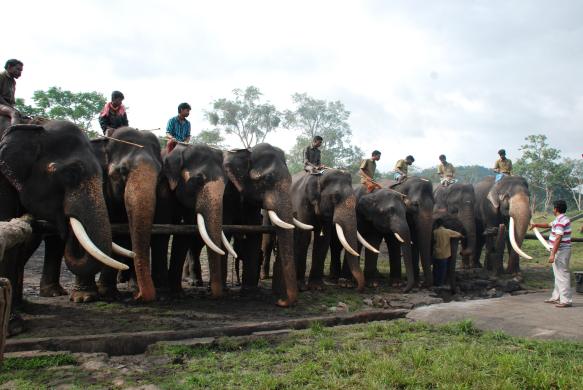
Moorthy (second from left) with his fellow camp-mates waiting to be fed, at the Theppakadu camp (2011)
Moorthy, according to my father had more stories to tell; quoting Peter Matthiessen again, there indeed was mystery behind that dark gray visage. And at some point, he wanted me to find answers for his unanswered questions. Years later, I find myself, in the shoes of an elephant biologist following elephants, wherever they go, be it day or night, trying to find answers for the unresolved ones; the ones I promised my father I would find for him.





